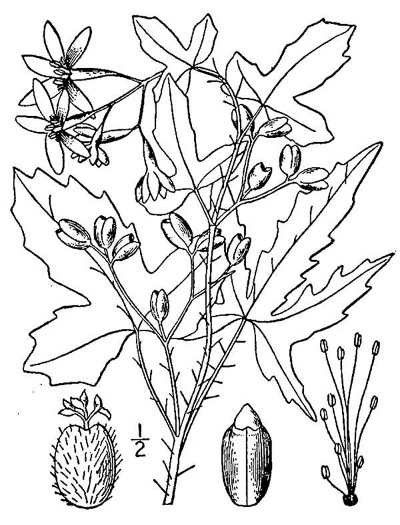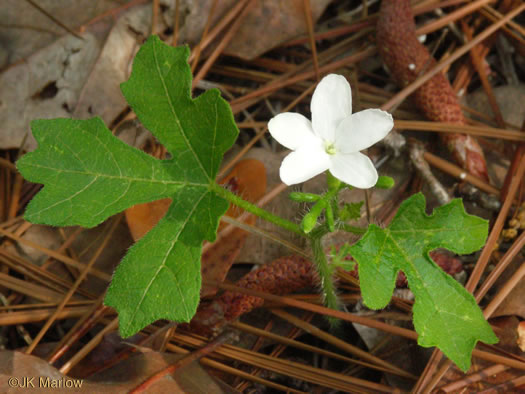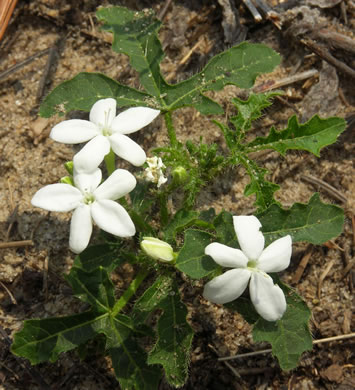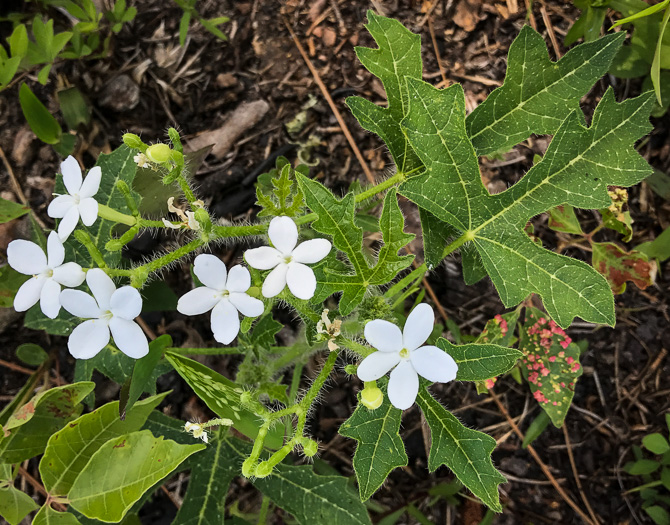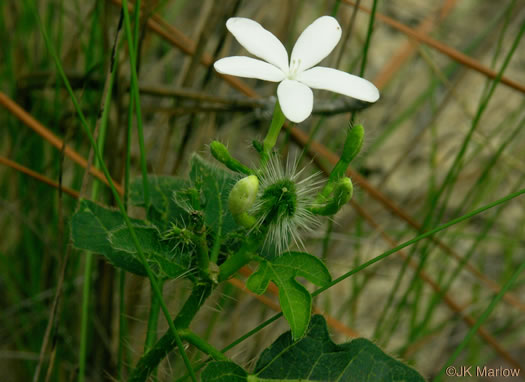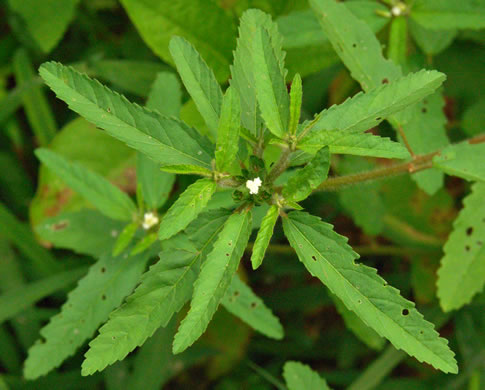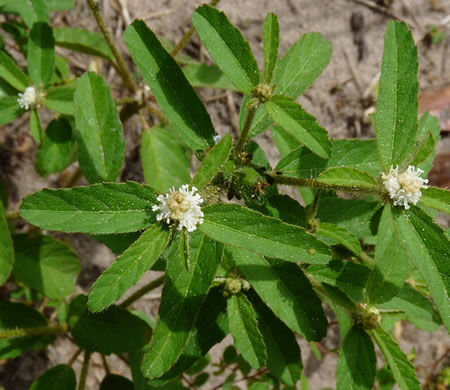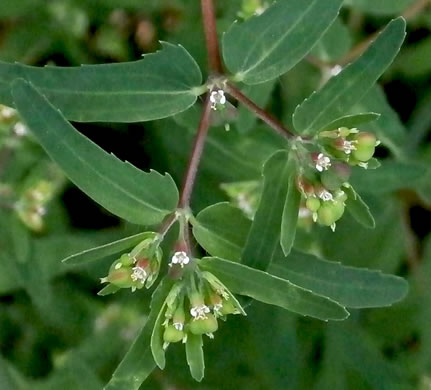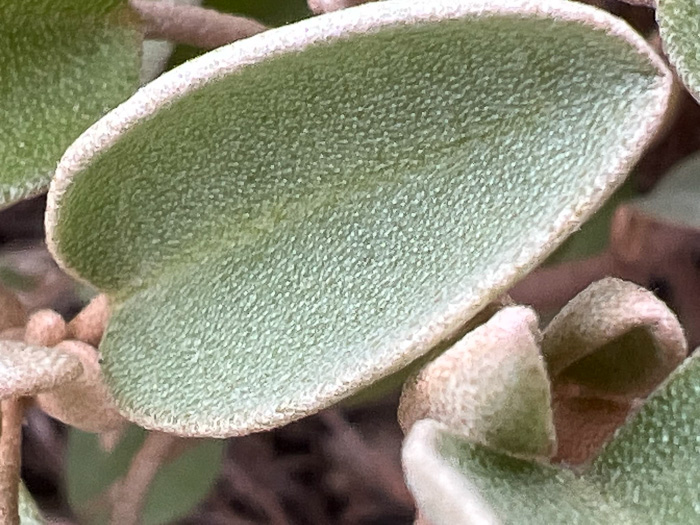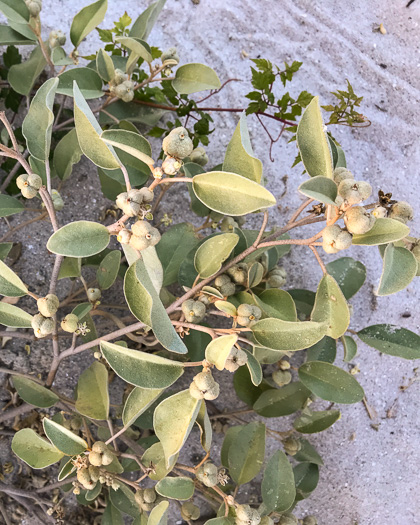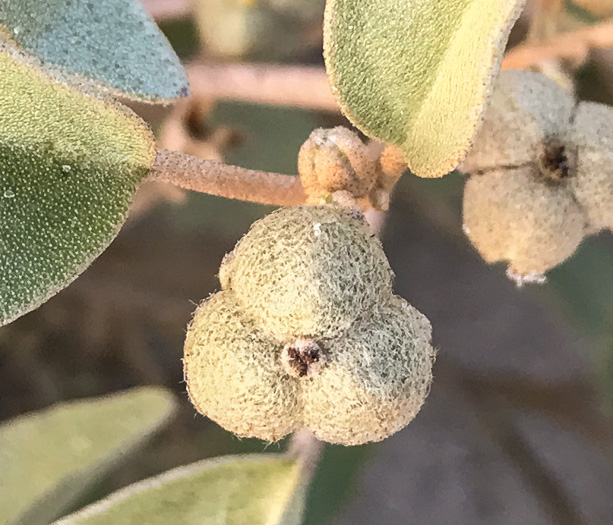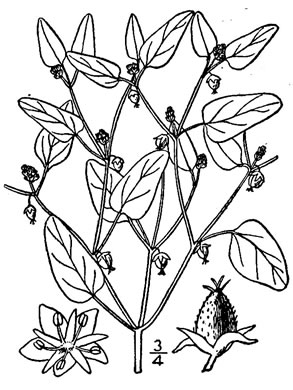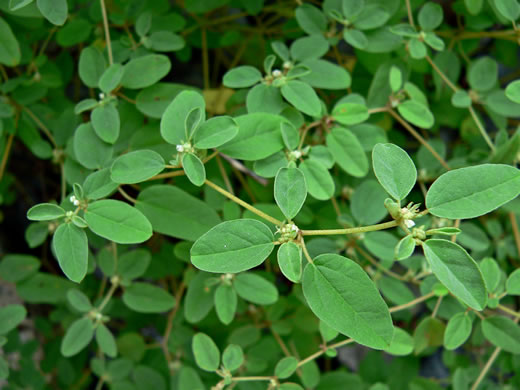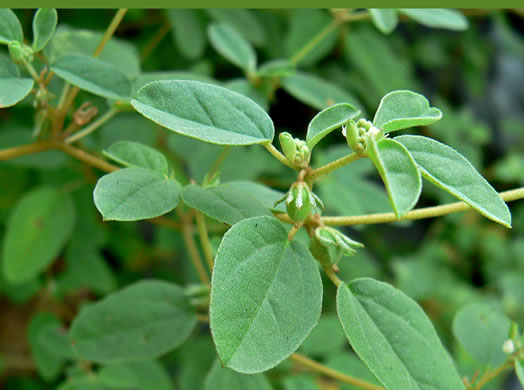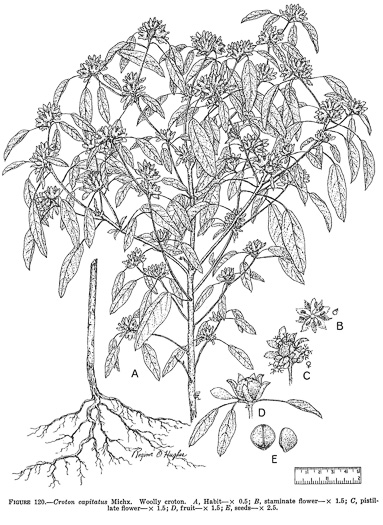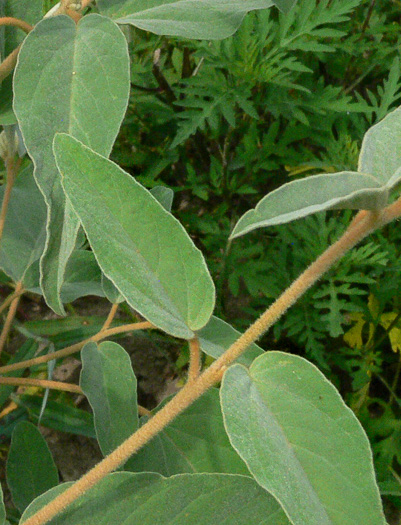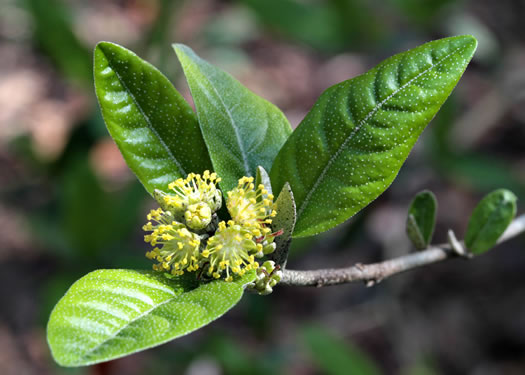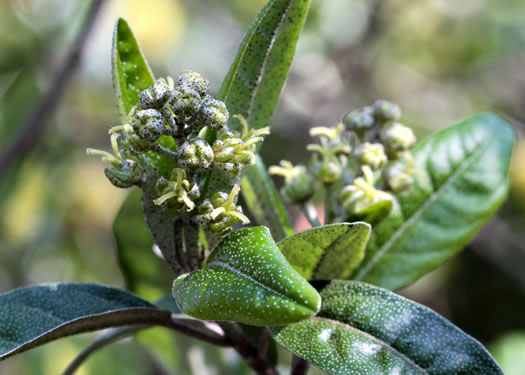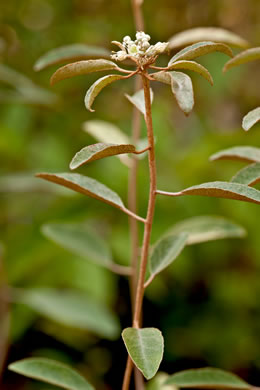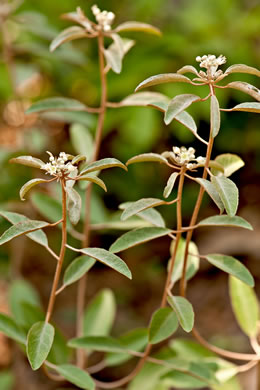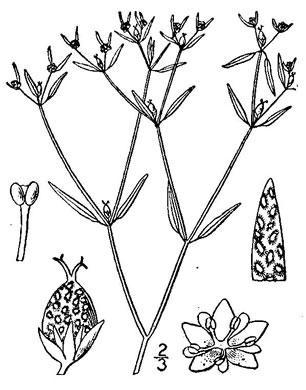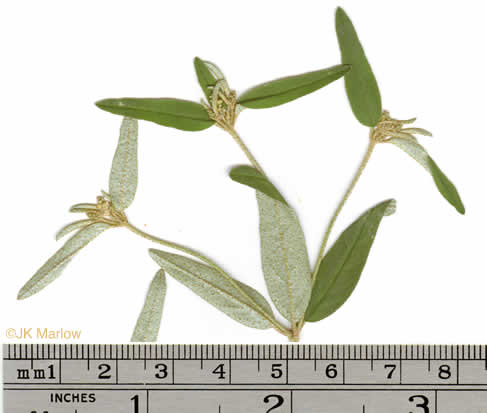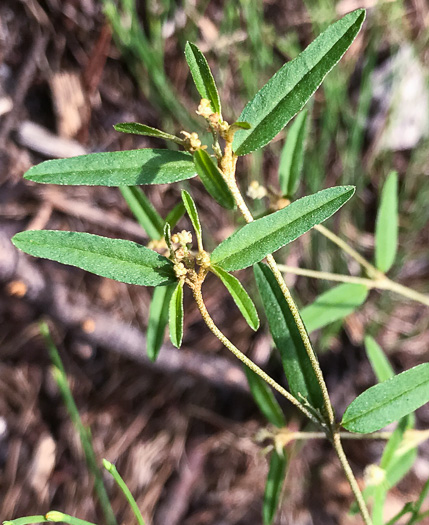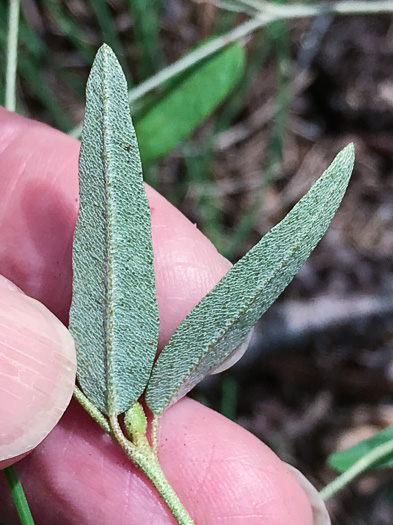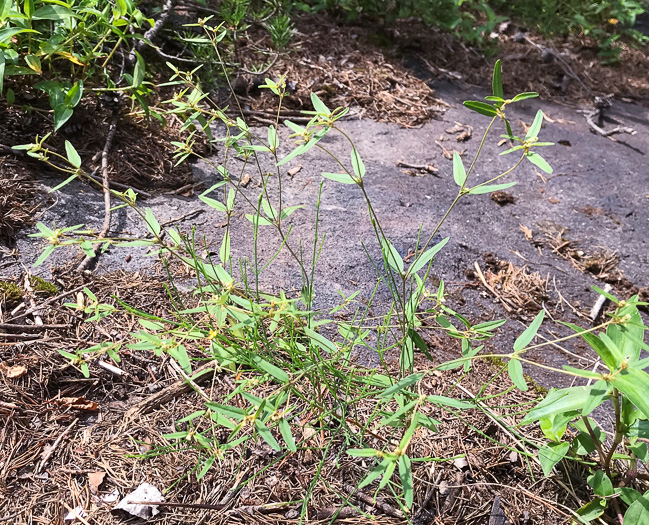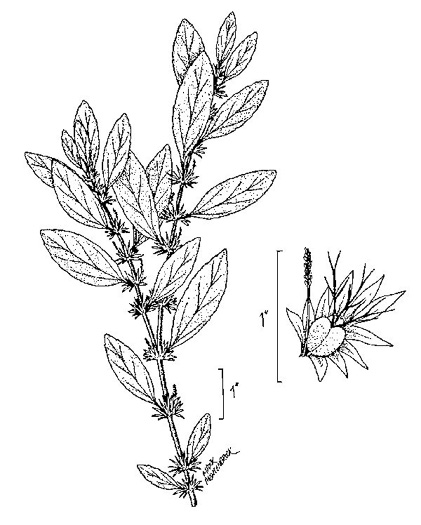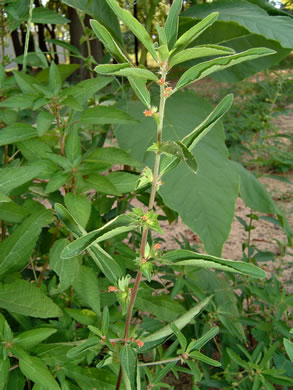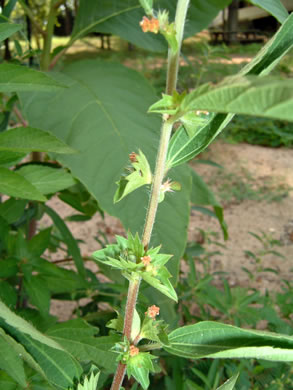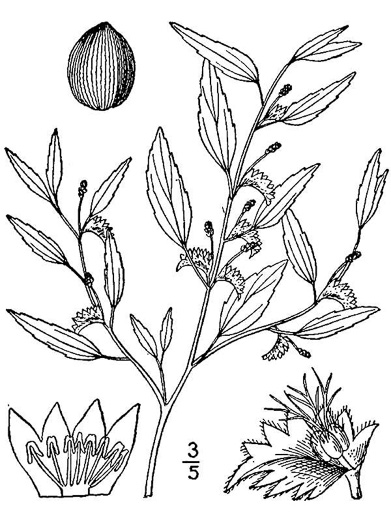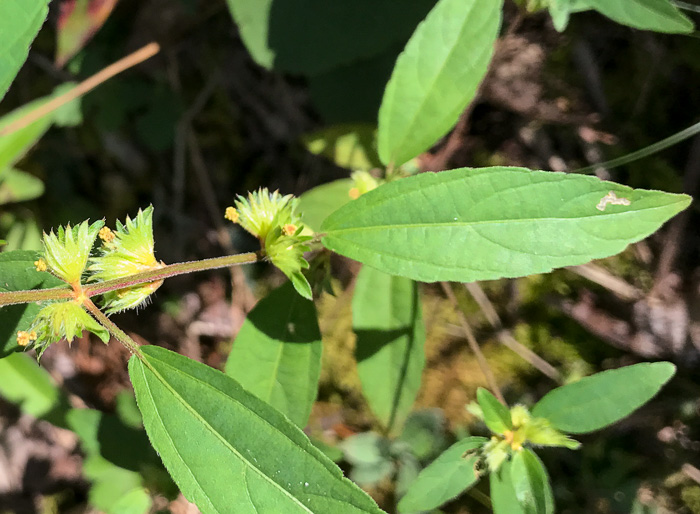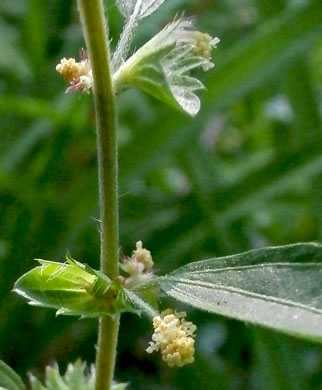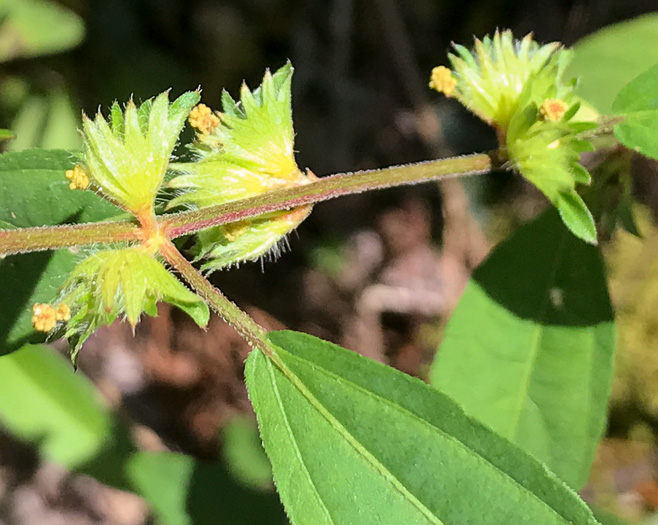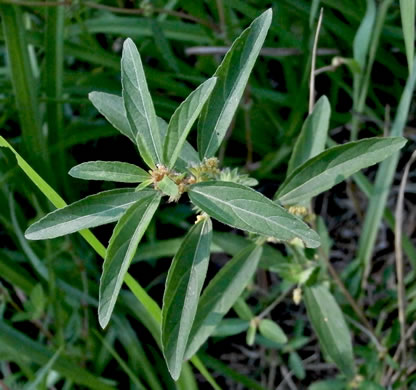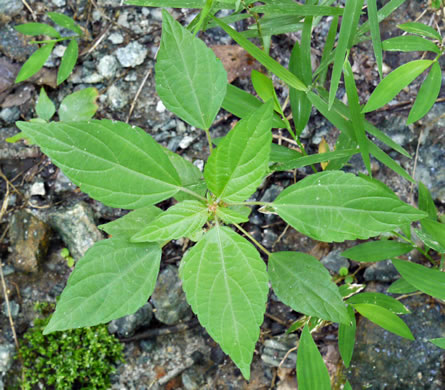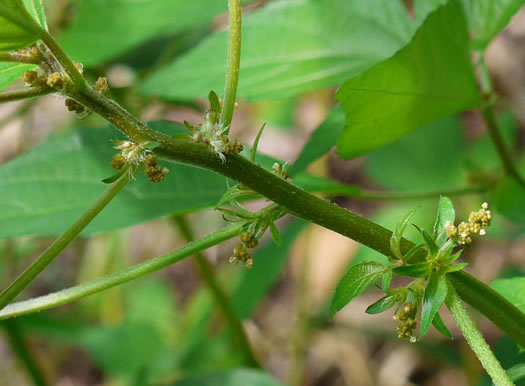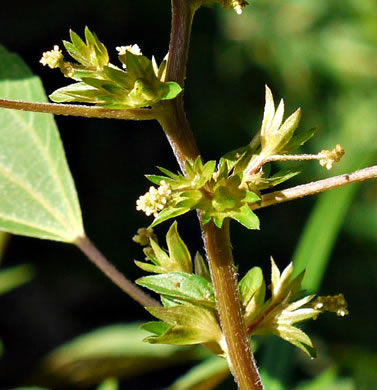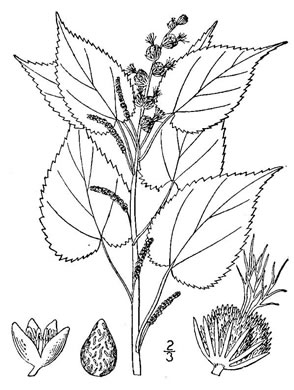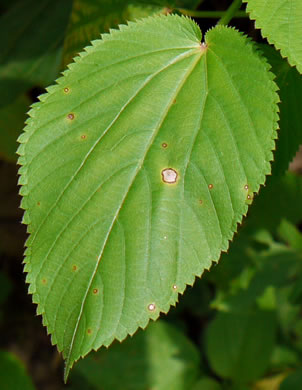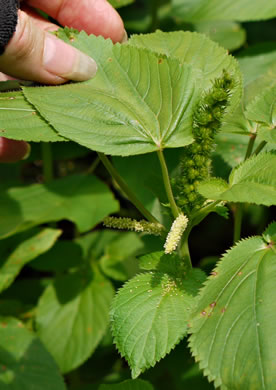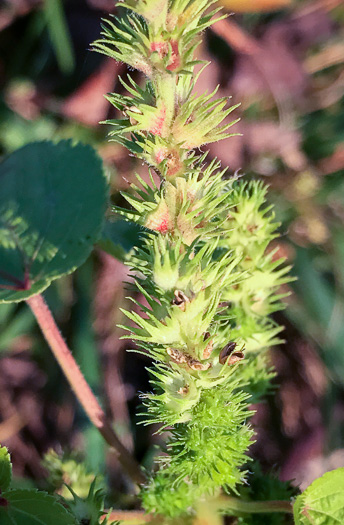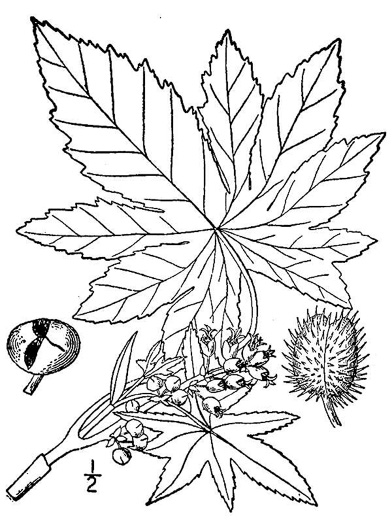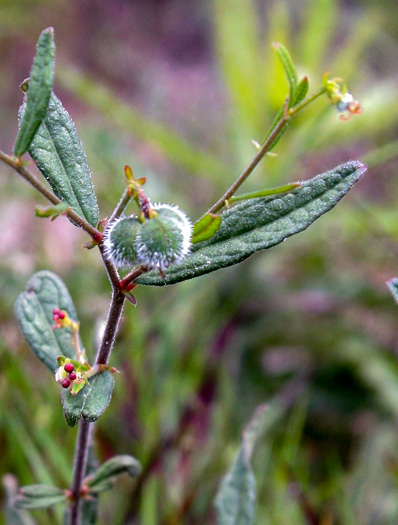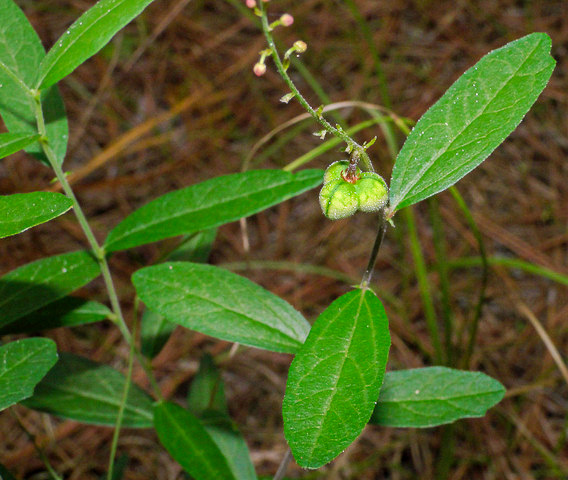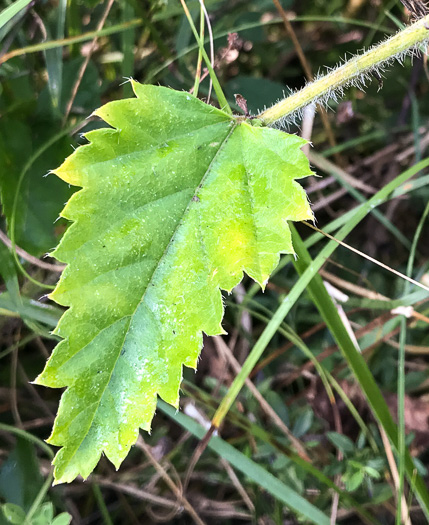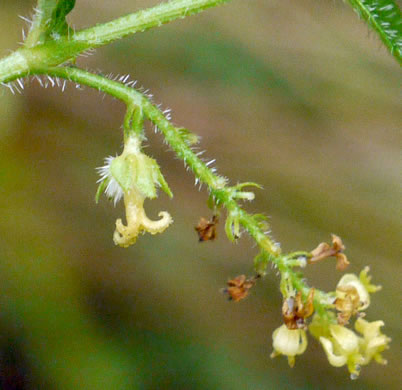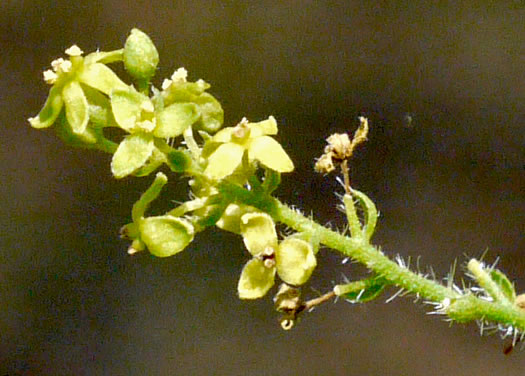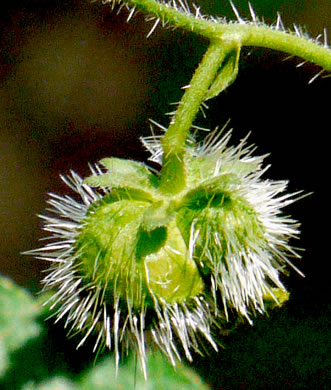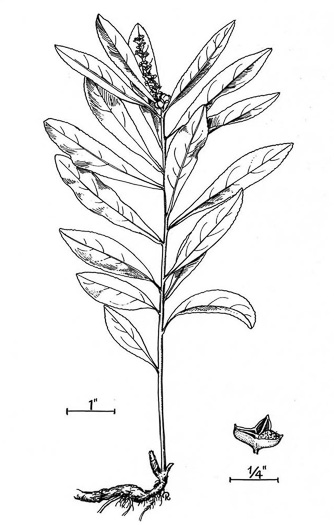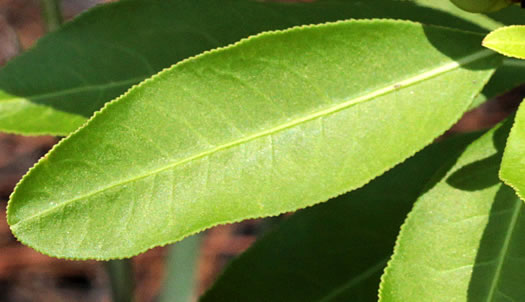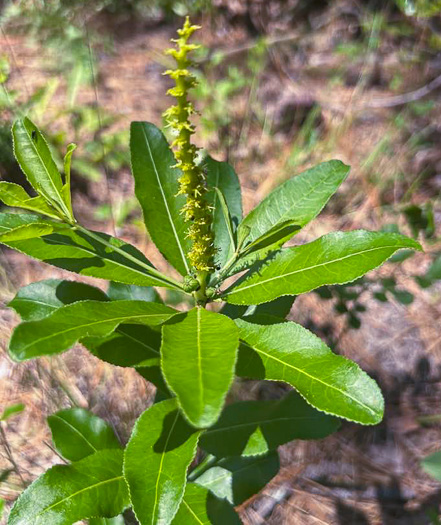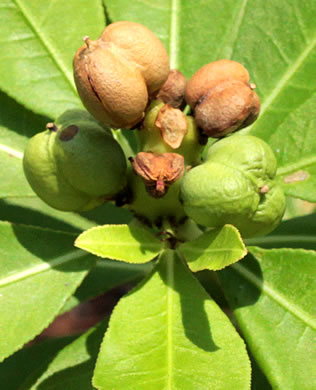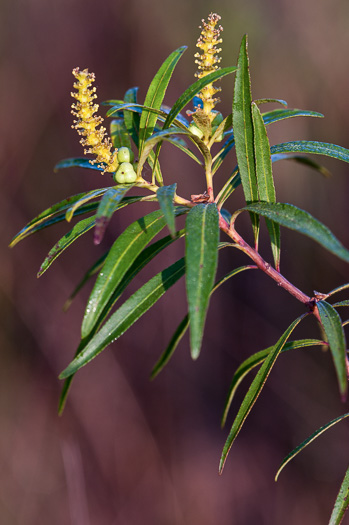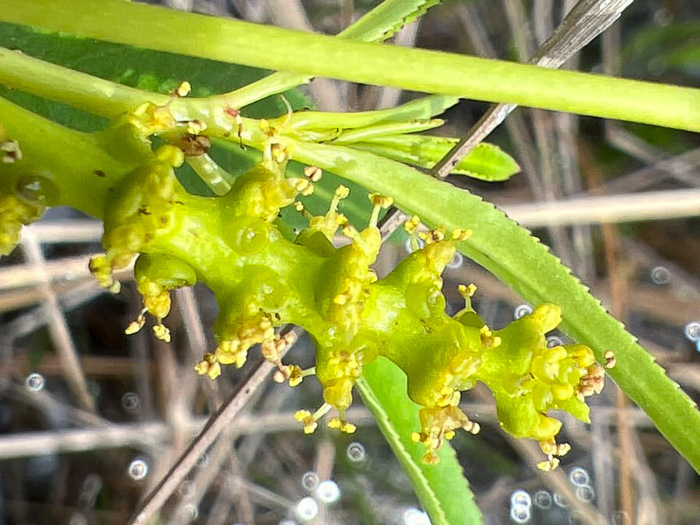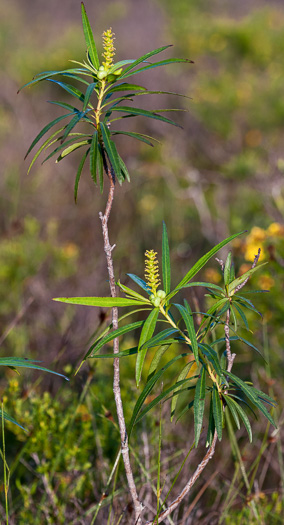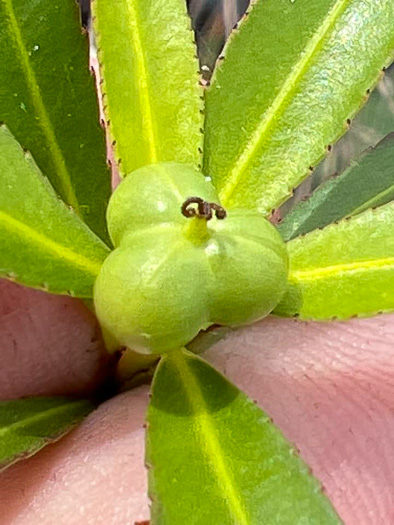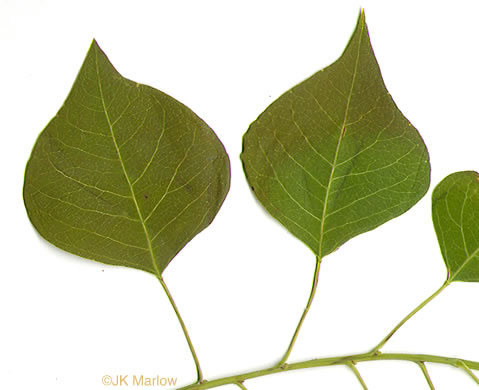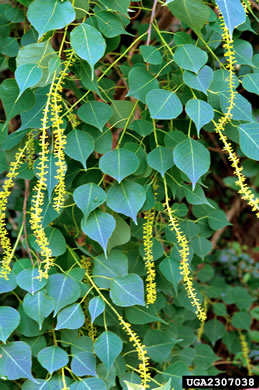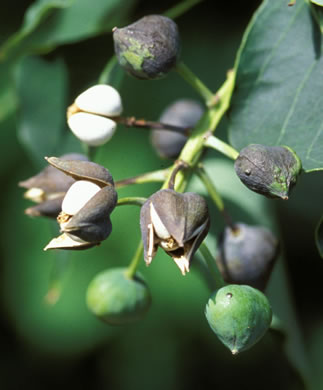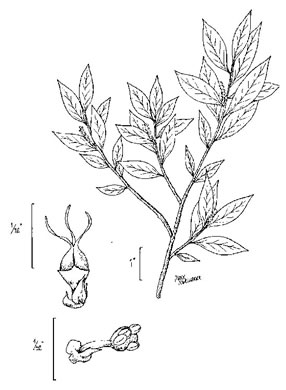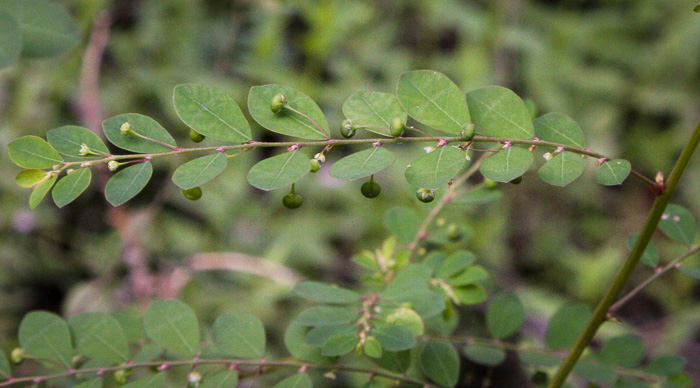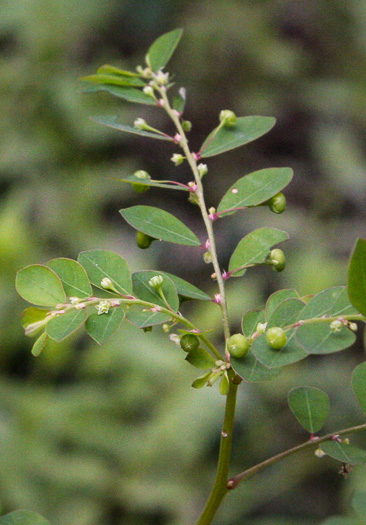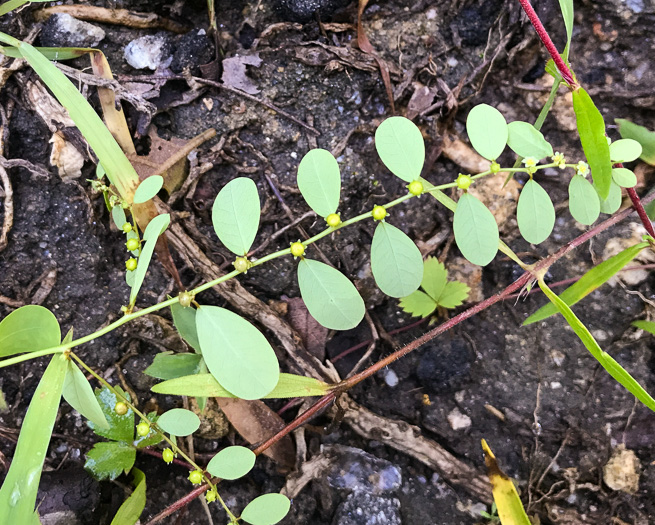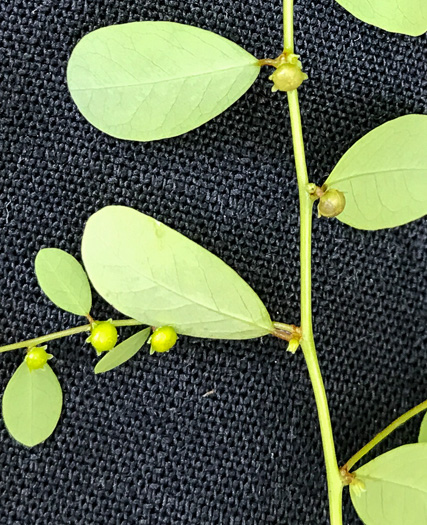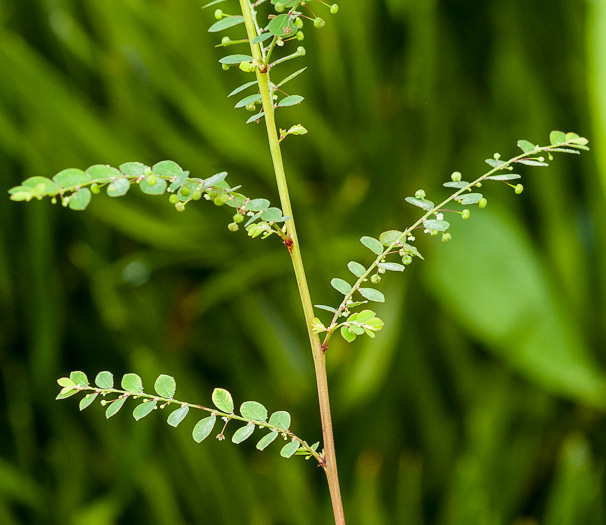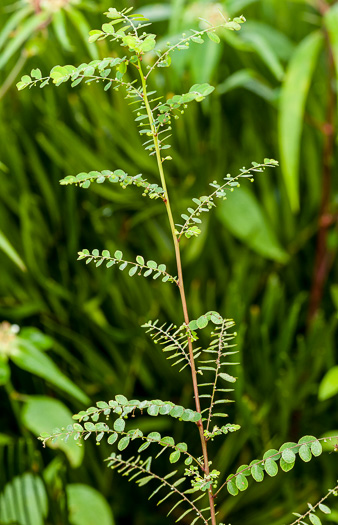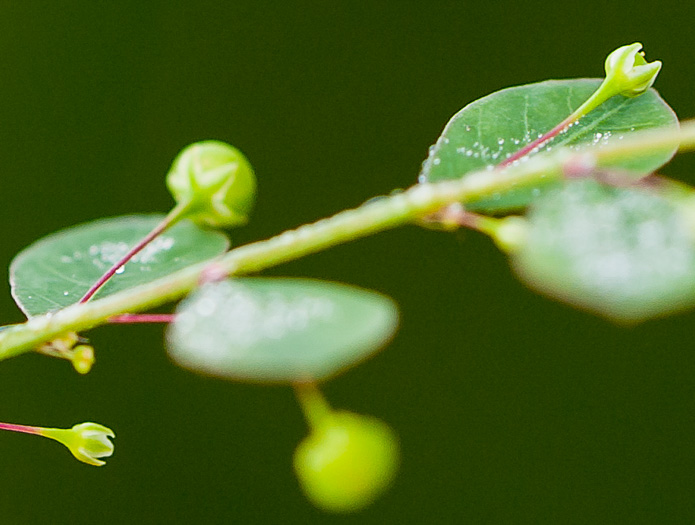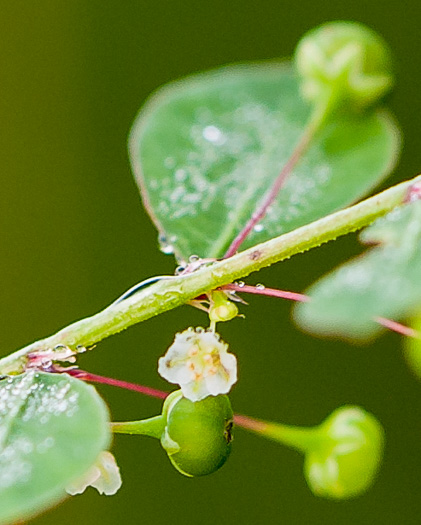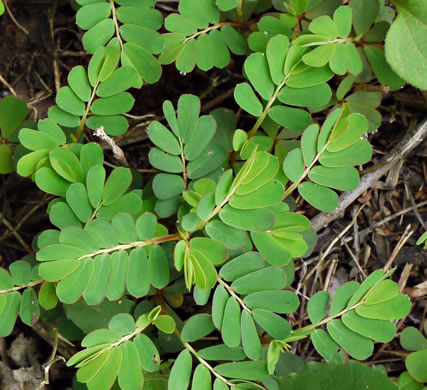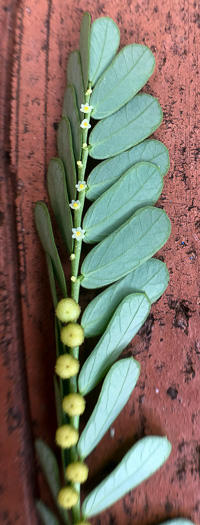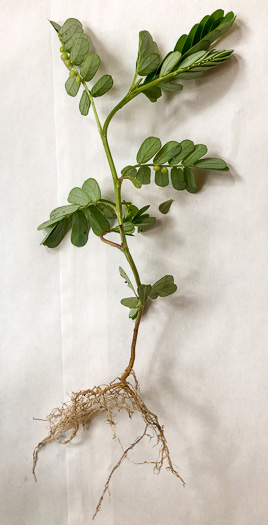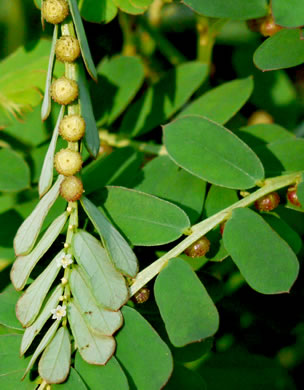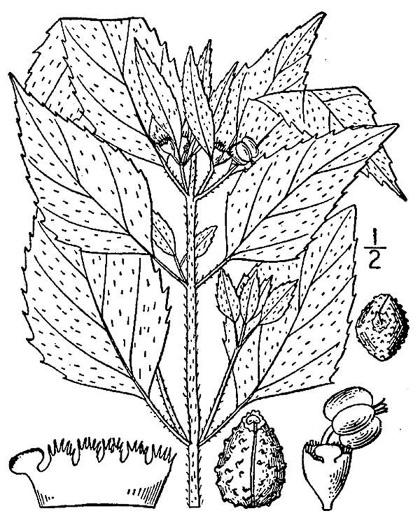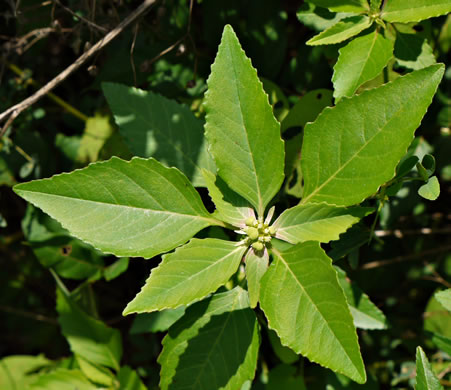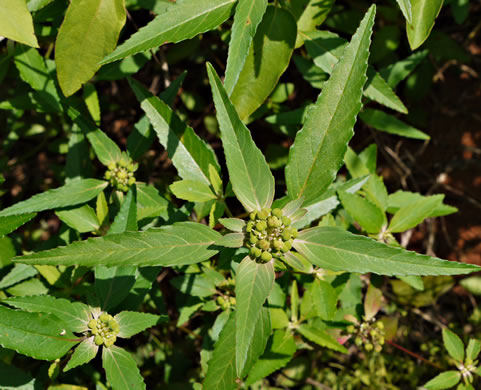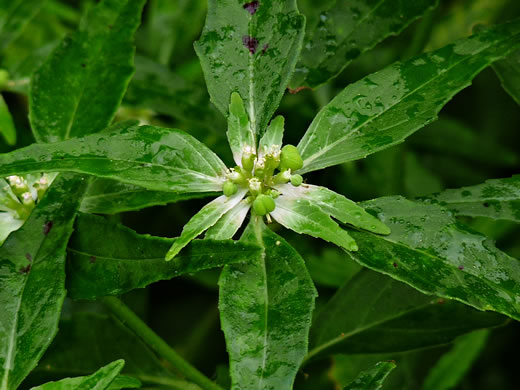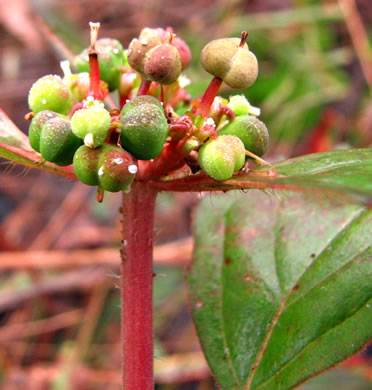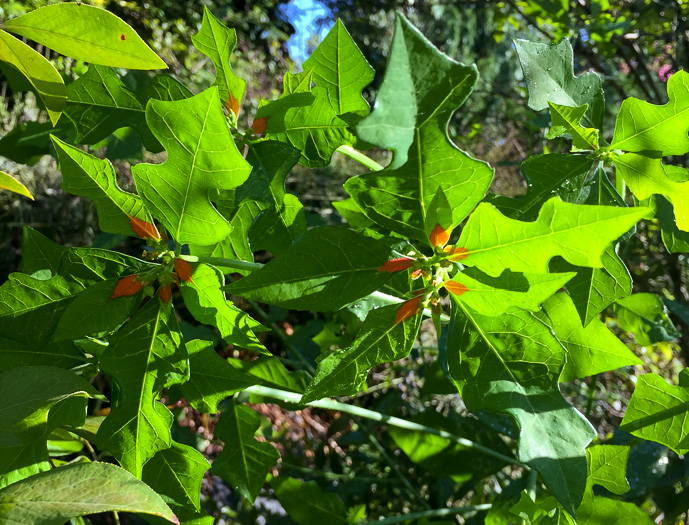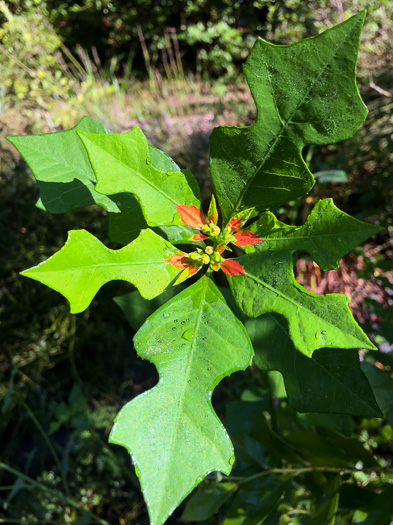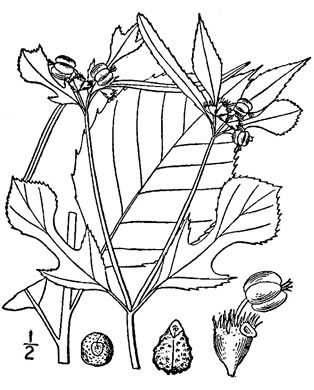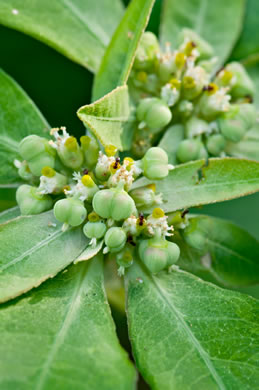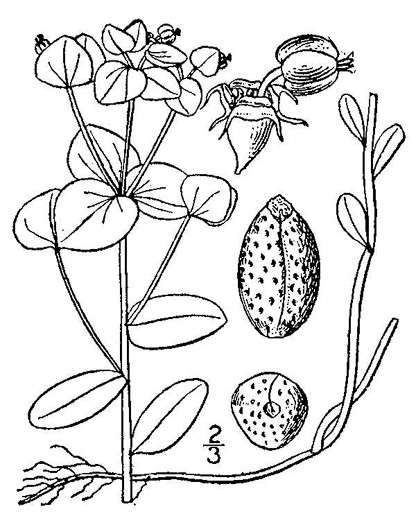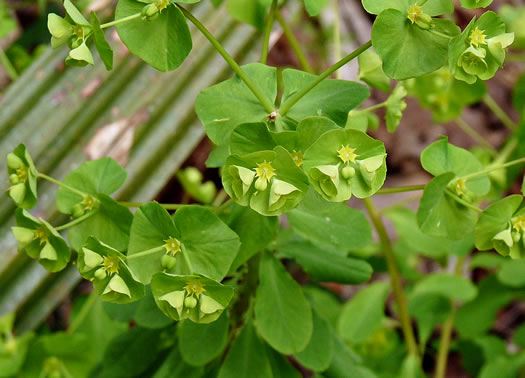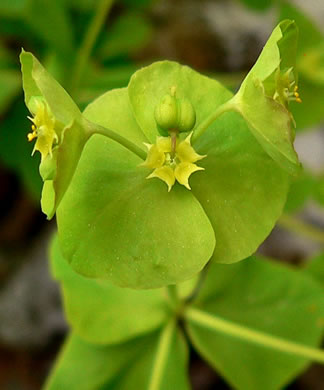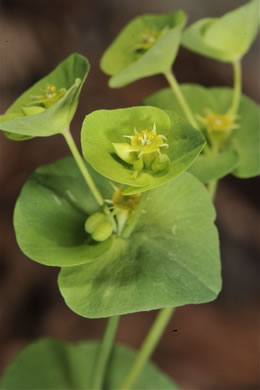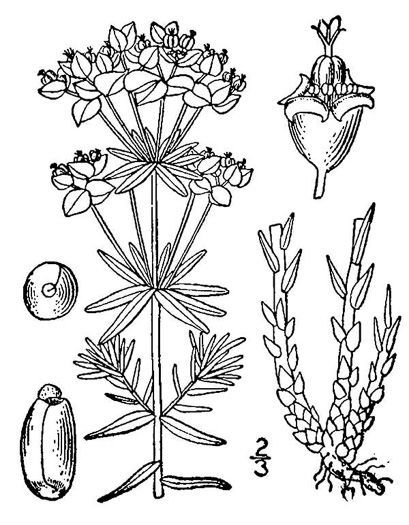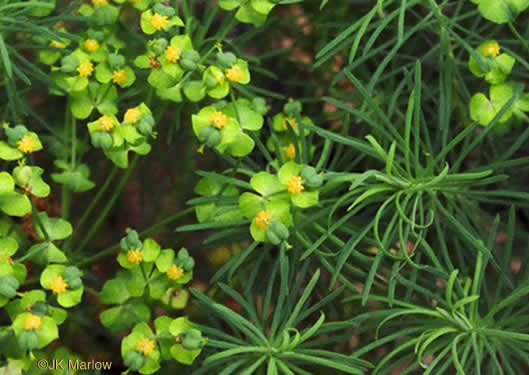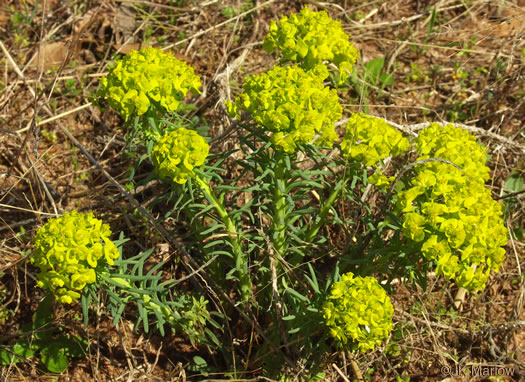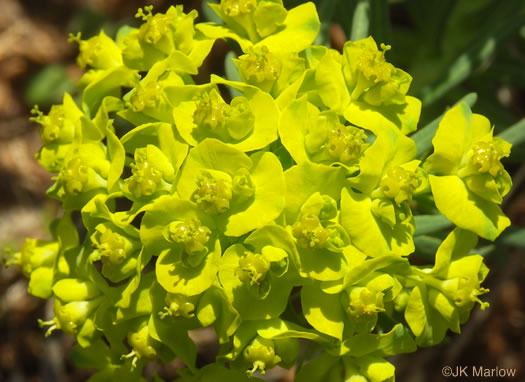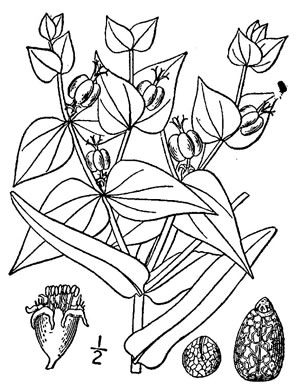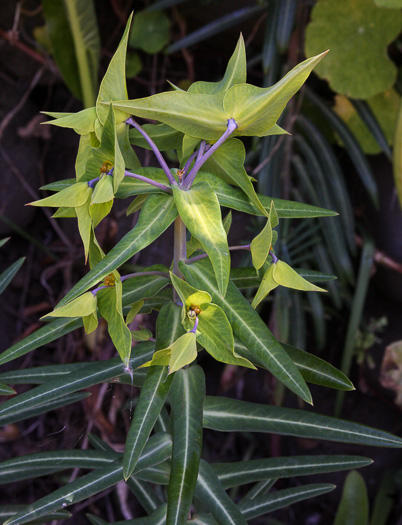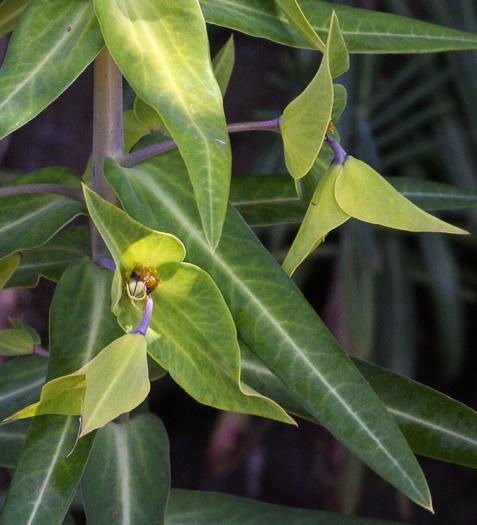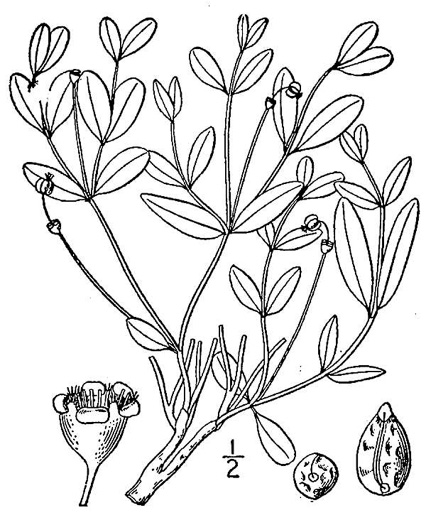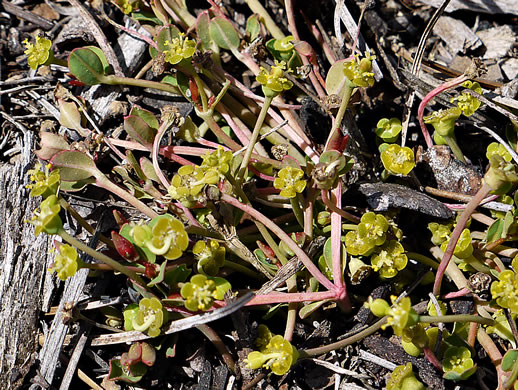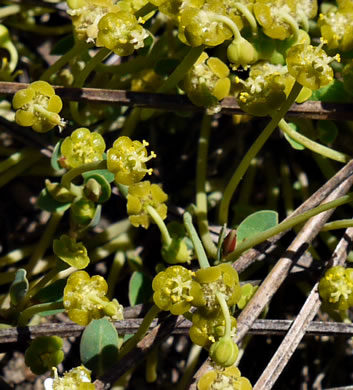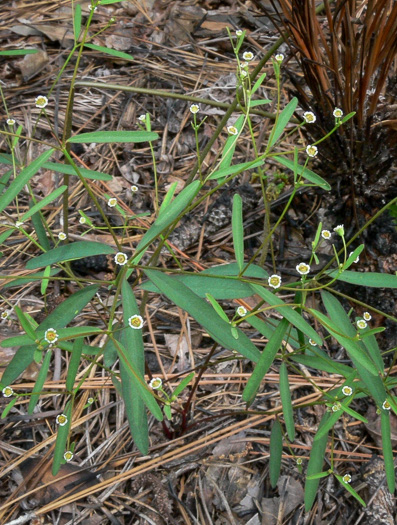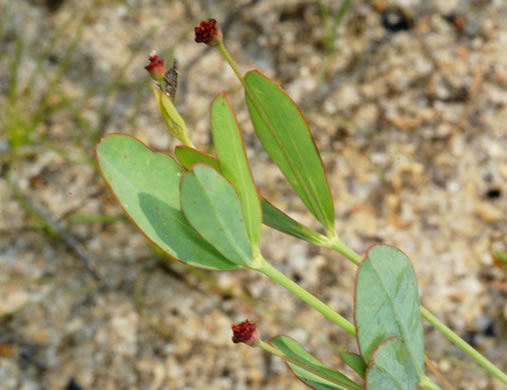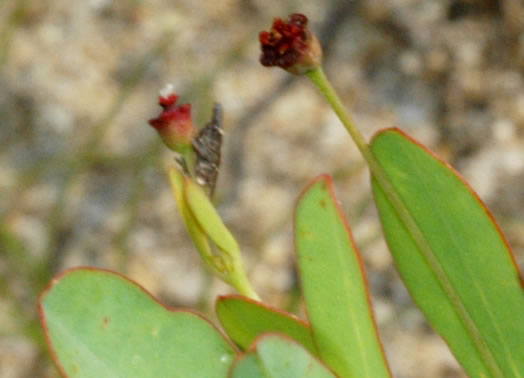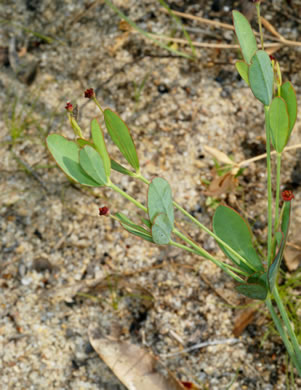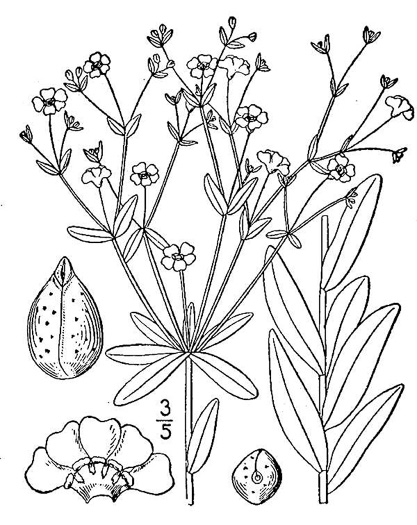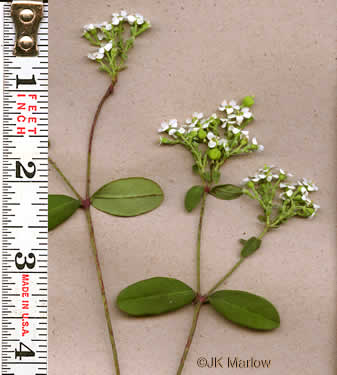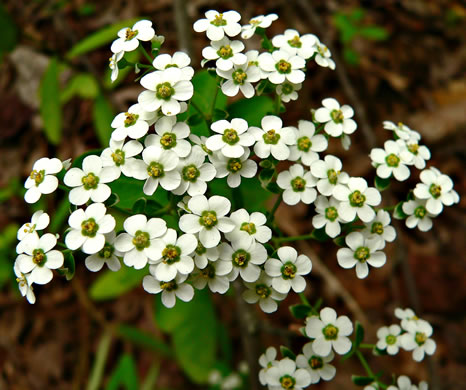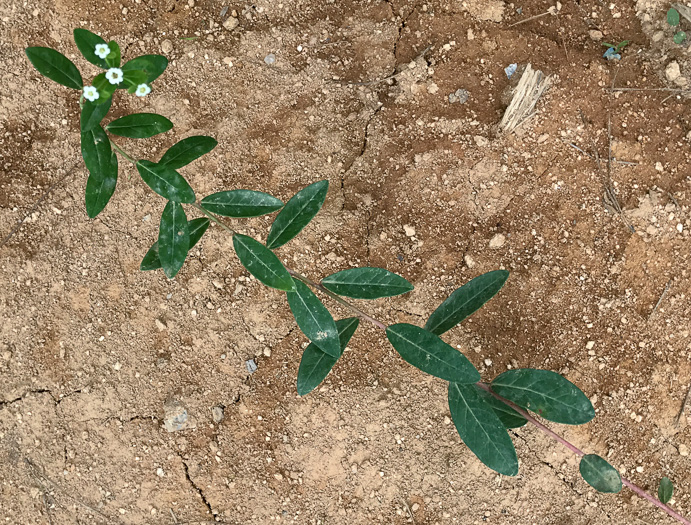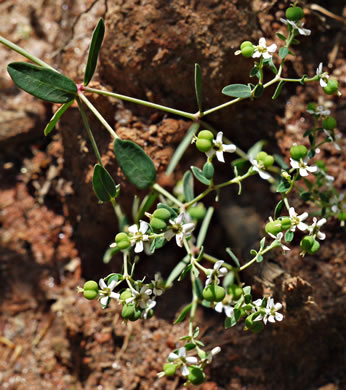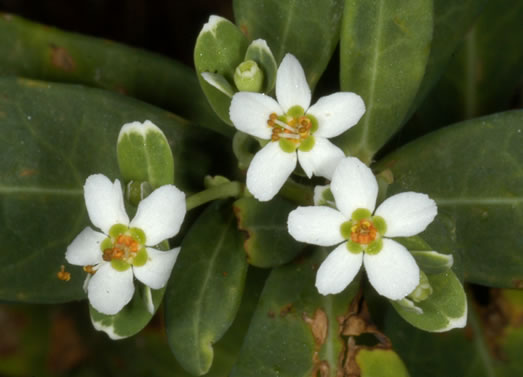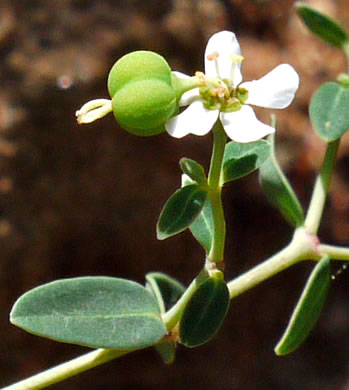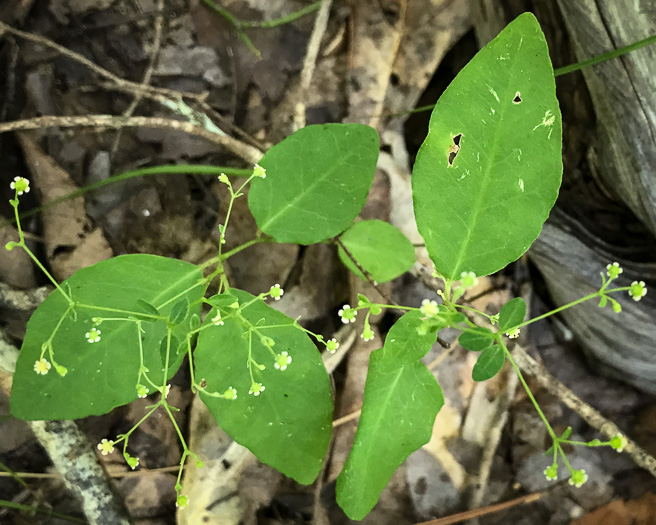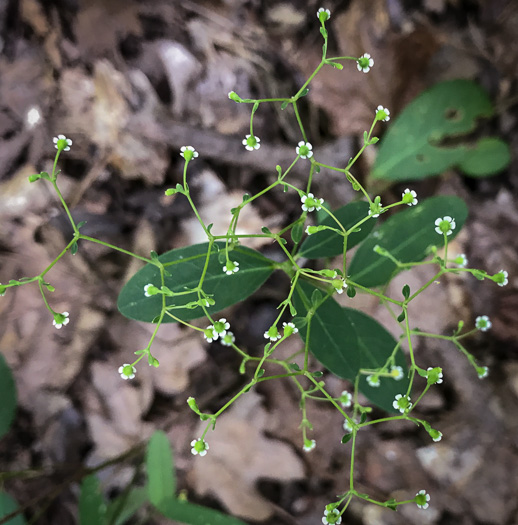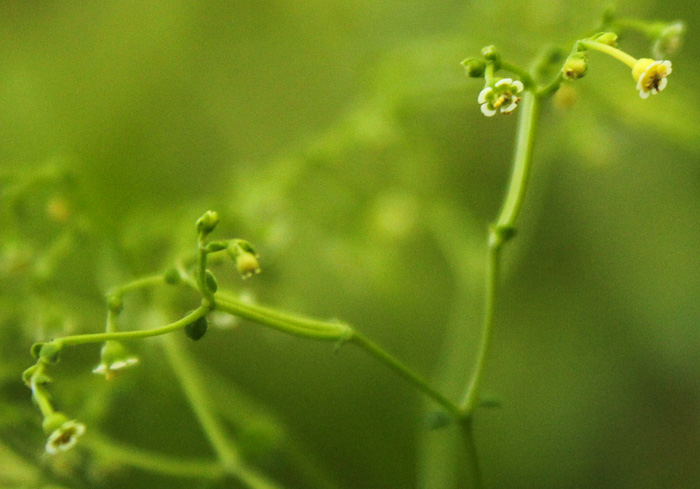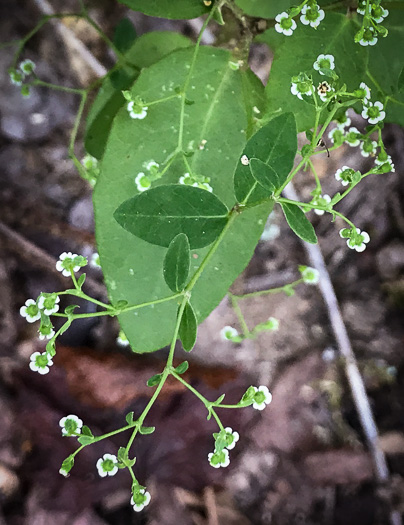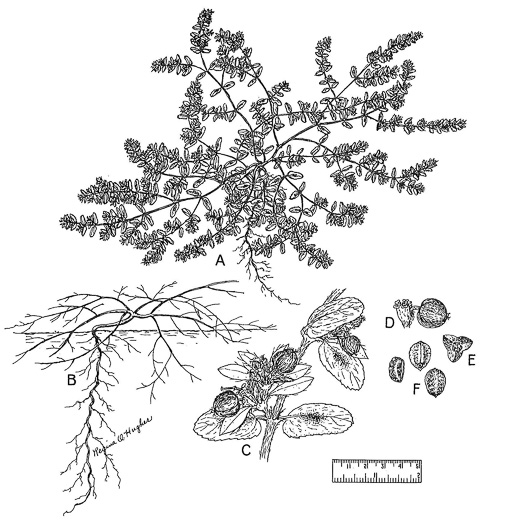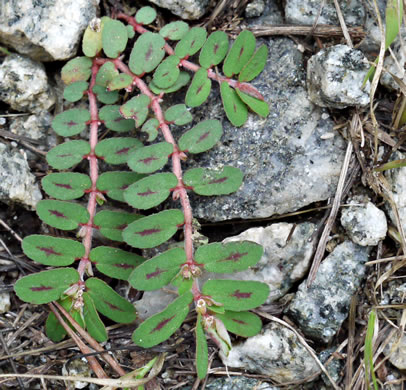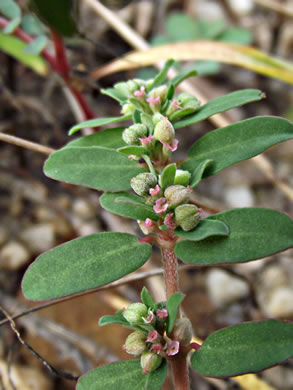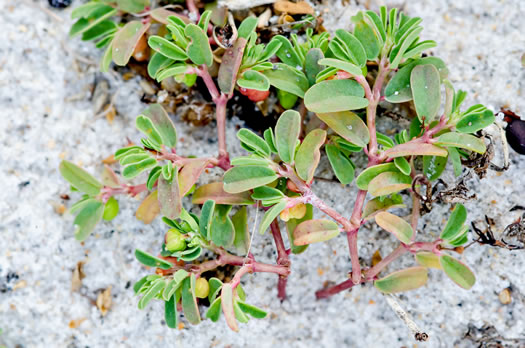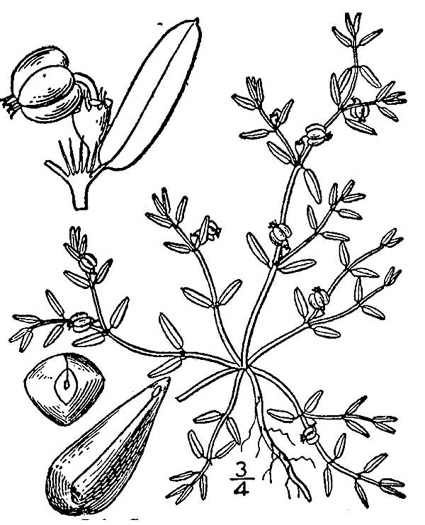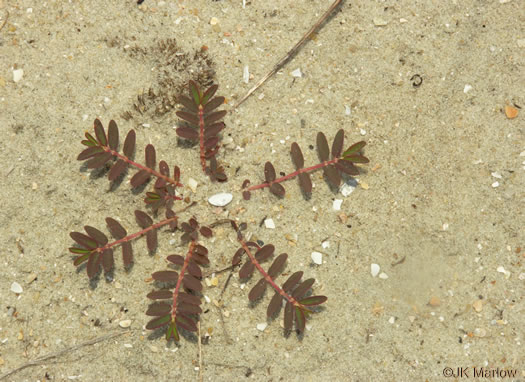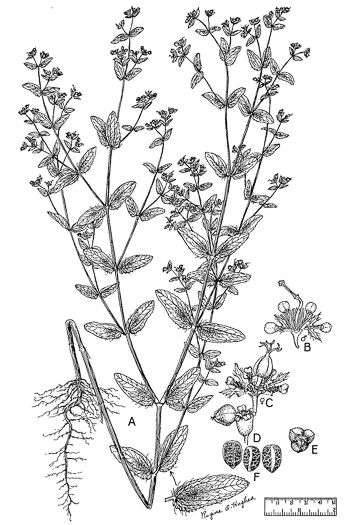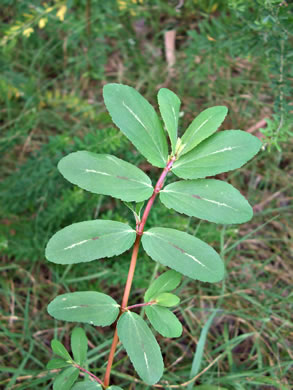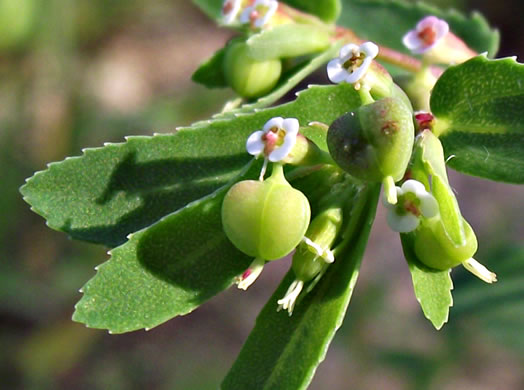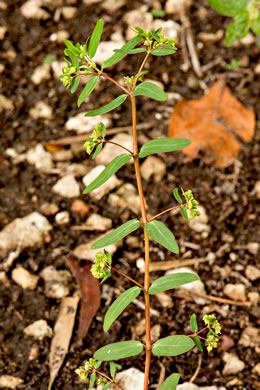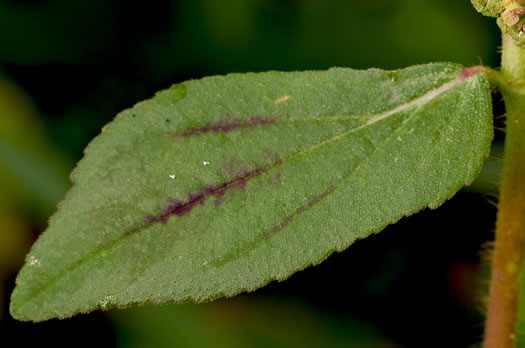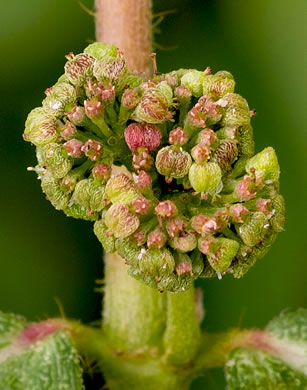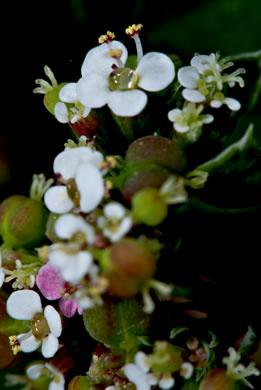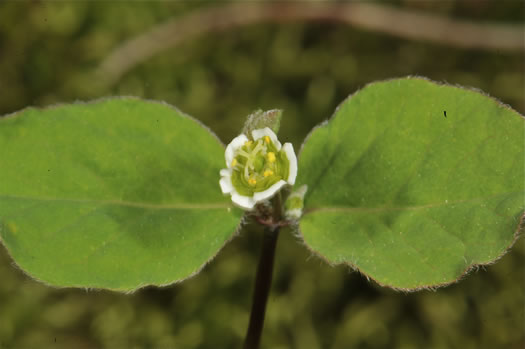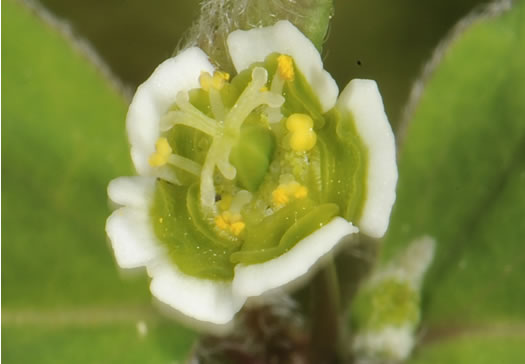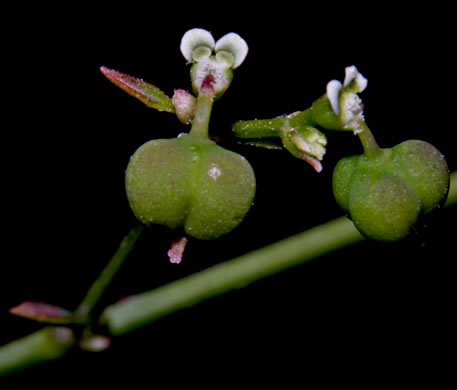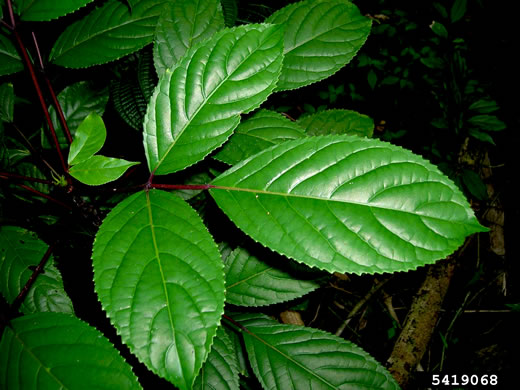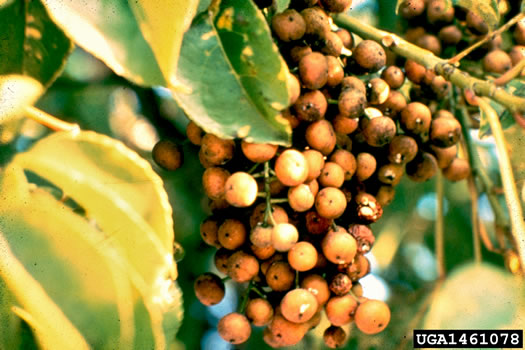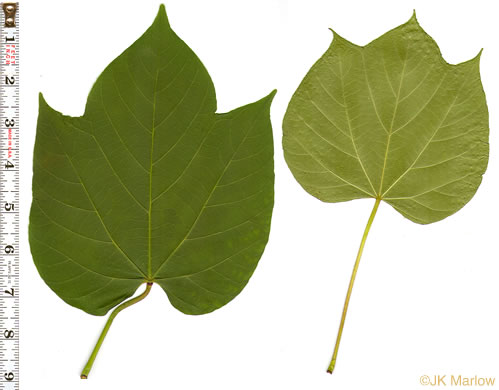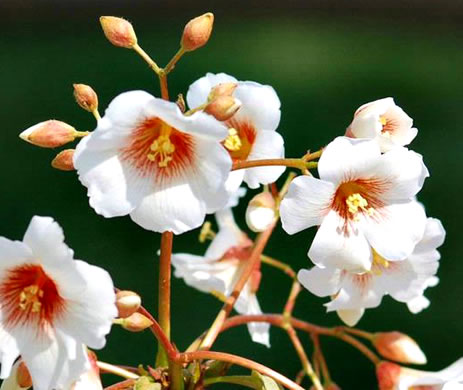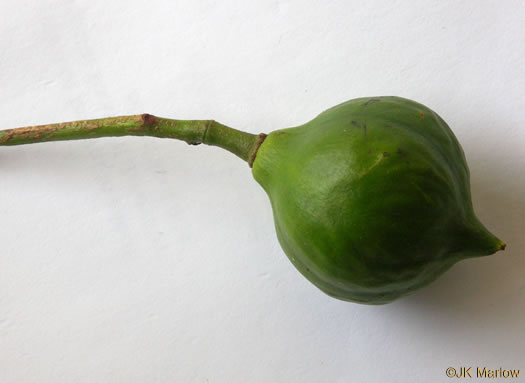Hovering over an image will enlarge it and point out features (works better on desktop than on mobile).
![]() A camera indicates there are pictures.
A camera indicates there are pictures.
![]() A speaker indicates that a botanical name is pronounced.
A speaker indicates that a botanical name is pronounced.
![]() A plus sign after a Latin name indicates that the species is further divided into varieties or subspecies.
A plus sign after a Latin name indicates that the species is further divided into varieties or subspecies.
Most habitat and range descriptions were obtained from Weakley's Flora.
Your search found 51 taxa in the family Euphorbiaceae, Spurge family, as understood by Vascular Flora of the Carolinas.

![]()
![]() Common Name:
Spurge-nettle, Tread-softly, Bull-nettle, Finger-rot
Common Name:
Spurge-nettle, Tread-softly, Bull-nettle, Finger-rot
Weakley's Flora: (4/24/22) Cnidoscolus stimulosus FAMILY: Euphorbiaceae
SYNONYMOUS WITH PLANTS National Database: Cnidoscolus urens var. stimulosus FAMILY: Euphorbiaceae
SYNONYMOUS WITH Vascular Flora of the Carolinas (Radford, Ahles, & Bell, 1968): Cnidoscolus stimulosus 107-01-001 FAMILY: Euphorbiaceae
Habitat: Longleaf pine sandhills, dry sandy woodlands, other dry sandy soils
Common in Coastal Plain (rare in Piedmont)
Native to the Carolinas & Georgia

![]()
![]() Common Name:
Doveweed, Tooth-leaved Croton, Sand Croton, Northern Croton
Common Name:
Doveweed, Tooth-leaved Croton, Sand Croton, Northern Croton
Weakley's Flora: (4/24/22) Croton glandulosus var. septentrionalis FAMILY: Euphorbiaceae
SYNONYMOUS WITH PLANTS National Database: Croton glandulosus var. septentrionalis FAMILY: Euphorbiaceae
INCLUDING Vascular Flora of the Carolinas (Radford, Ahles, & Bell, 1968): Croton glandulosus var. septentrionalis 107-02-001 FAMILY: Euphorbiaceae
Habitat: Fields, roadsides, disturbed areas
Common
Non-native? its pre-Columbian range obscure because of its weedy nature

![]()
![]() Common Name:
Silverleaf Croton, Gulf Croton, Beach-tea
Common Name:
Silverleaf Croton, Gulf Croton, Beach-tea
Weakley's Flora: (4/24/22) Croton punctatus FAMILY: Euphorbiaceae
SYNONYMOUS WITH PLANTS National Database: Croton punctatus FAMILY: Euphorbiaceae
SYNONYMOUS WITH Vascular Flora of the Carolinas (Radford, Ahles, & Bell, 1968): Croton punctatus 107-02-002 FAMILY: Euphorbiaceae
Habitat: Beach dunes, coastal grasslands, usually with Uniola paniculata and/or Spartina patens
Common in Coastal Plain
Native to the Carolinas & Georgia

![]() Common Name:
Prairie-tea Croton, One-seed Croton
Common Name:
Prairie-tea Croton, One-seed Croton
Weakley's Flora: (4/24/22) Croton monanthogynus FAMILY: Euphorbiaceae
SYNONYMOUS WITH PLANTS National Database: Croton monanthogynus FAMILY: Euphorbiaceae
SYNONYMOUS WITH Vascular Flora of the Carolinas (Radford, Ahles, & Bell, 1968): Croton monanthogynus 107-02-004 FAMILY: Euphorbiaceae
Habitat: Limestone outcrops, blackland prairies, disturbed dry soil
Rare
Native to Georgia

![]() Common Name:
Woolly Croton, Hogwort, Capitate Croton, Goatweed
Common Name:
Woolly Croton, Hogwort, Capitate Croton, Goatweed
Weakley's Flora: (4/24/22) Croton capitatus FAMILY: Euphorbiaceae
SYNONYMOUS WITH PLANTS National Database: Croton capitatus var. capitatus FAMILY: Euphorbiaceae
INCLUDED WITHIN Vascular Flora of the Carolinas (Radford, Ahles, & Bell, 1968): Croton capitatus 107-02-005? FAMILY: Euphorbiaceae
Habitat: Glades, prairies, woodlands, fields, disturbed areas
Common in GA, uncommon in SC, rare in NC
Native: west of the Carolinas & Georgia, original native distribution unclear

![]()
![]() Common Name:
Alabama Croton
Common Name:
Alabama Croton
Weakley's Flora: (4/24/22) Croton alabamensis var. alabamensis FAMILY: Euphorbiaceae
SYNONYMOUS WITH PLANTS National Database: Croton alabamensis var. alabamensis FAMILY: Euphorbiaceae
Habitat: Dry to mesic limestone and dolostone glades, woodlands, and wooded ravines
Native: west of Georgia

![]() Common Name:
Silver Croton, Sandhill Croton, Healing Croton
Common Name:
Silver Croton, Sandhill Croton, Healing Croton
Weakley's Flora: (4/24/22) Croton argyranthemus FAMILY: Euphorbiaceae
SYNONYMOUS WITH PLANTS National Database: Croton argyranthemus FAMILY: Euphorbiaceae
Habitat: Longleaf pine sandhills, other dry sands
Common in GA Coastal Plain
Native to Georgia

Common Name: Elliott's Croton, Pondshore Croton
Weakley's Flora: (4/24/22) Croton elliottii FAMILY: Euphorbiaceae
SYNONYMOUS WITH PLANTS National Database: Croton elliottii FAMILY: Euphorbiaceae
Habitat: Shores and exposed drawdown zones of clay-based Carolina bays and limesink ponds (dolines)
Rare
Native to South Carolina & Georgia

Common Name: Sand Rushfoil, Michaux's Croton, Narrowleaf Rushfoil
Weakley's Flora: (4/24/22) Croton michauxii FAMILY: Euphorbiaceae
SYNONYMOUS WITH PLANTS National Database: Croton michauxii FAMILY: Euphorbiaceae
SYNONYMOUS WITH Vascular Flora of the Carolinas (Radford, Ahles, & Bell, 1968): Crotonopsis linearis 107-03-001 FAMILY: Euphorbiaceae
Habitat: Longleaf pine sandhills, disturbed sandy soils
Uncommon in GA Coastal Plain (rare elsewhere in GA-NC-SC)
Native to the Carolinas & Georgia

![]()
![]() Common Name:
Outcrop Rushfoil, Willdenow's Croton, Glade Rushfoil, Broadleaf Rushfoil
Common Name:
Outcrop Rushfoil, Willdenow's Croton, Glade Rushfoil, Broadleaf Rushfoil
Weakley's Flora: (4/24/22) Croton willdenowii FAMILY: Euphorbiaceae
SYNONYMOUS WITH PLANTS National Database: Croton michauxii var. ellipticus FAMILY: Euphorbiaceae
SYNONYMOUS WITH Vascular Flora of the Carolinas (Radford, Ahles, & Bell, 1968): Crotonopsis elliptica 107-03-002 FAMILY: Euphorbiaceae
Habitat: Granitic flatrocks, diabase barrens, calcareous barrens, thin soils around other rock outcrops, open woodlands, disturbed sandy soil
Common (rare in Carolina Coastal Plain)
Native to the Carolinas & Georgia

![]()
![]() Common Name:
Virginia Threeseed Mercury, Virginia Copperleaf, Shortstalk Copperleaf
Common Name:
Virginia Threeseed Mercury, Virginia Copperleaf, Shortstalk Copperleaf
Weakley's Flora: (4/24/22) Acalypha virginica FAMILY: Euphorbiaceae
SYNONYMOUS WITH PLANTS National Database: Acalypha virginica FAMILY: Euphorbiaceae
SYNONYMOUS WITH Vascular Flora of the Carolinas (Radford, Ahles, & Bell, 1968): Acalypha virginica 107-04-001 FAMILY: Euphorbiaceae
Habitat: Woodlands and disturbed ground
Common (rare in Coastal Plain)
Native to the Carolinas & Georgia

![]() Common Name:
Slender Threeseed Mercury, Slender Copperleaf, Shortstalk Copperleaf
Common Name:
Slender Threeseed Mercury, Slender Copperleaf, Shortstalk Copperleaf
Weakley's Flora: (4/24/22) Acalypha gracilens FAMILY: Euphorbiaceae
SYNONYMOUS WITH PLANTS National Database: Acalypha gracilens FAMILY: Euphorbiaceae
SYNONYMOUS WITH Vascular Flora of the Carolinas (Radford, Ahles, & Bell, 1968): Acalypha gracilens 107-04-002 FAMILY: Euphorbiaceae
Habitat: Woodlands, disturbed ground
Common (rare in NC Mountains)
Native to the Carolinas & Georgia

![]() Common Name:
Common Threeseed Mercury, Rhombic Copperleaf
Common Name:
Common Threeseed Mercury, Rhombic Copperleaf
Weakley's Flora: (4/24/22) Acalypha rhomboidea FAMILY: Euphorbiaceae
SYNONYMOUS WITH PLANTS National Database: Acalypha rhomboidea FAMILY: Euphorbiaceae
SYNONYMOUS WITH Vascular Flora of the Carolinas (Radford, Ahles, & Bell, 1968): Acalypha rhomboidea 107-04-003 FAMILY: Euphorbiaceae
Habitat: Woodlands, disturbed ground
Common
Native to the Carolinas & Georgia

![]() Common Name:
Pineland Threeseed Mercury, Hophornbeam Copperleaf, Roughpod Copperleaf
Common Name:
Pineland Threeseed Mercury, Hophornbeam Copperleaf, Roughpod Copperleaf
Weakley's Flora: (4/24/22) Acalypha ostryifolia FAMILY: Euphorbiaceae
SYNONYMOUS WITH PLANTS National Database: Acalypha ostryifolia FAMILY: Euphorbiaceae
SYNONYMOUS WITH (ORTHOGRAPHIC VARIANT) Vascular Flora of the Carolinas (Radford, Ahles, & Bell, 1968): Acalypha ostryaefolia 107-04-004 FAMILY: Euphorbiaceae
Habitat: Dry, sandy soil of woodlands, disturbed ground, ditches
Uncommon (rare in Carolina Mountains)
Possibly native to GA (introduced in Carolinas)

Common Name: Cuban Copperleaf
Weakley's Flora: (4/24/22) Acalypha setosa FAMILY: Euphorbiaceae
SYNONYMOUS WITH PLANTS National Database: Acalypha setosa FAMILY: Euphorbiaceae
SYNONYMOUS WITH Vascular Flora of the Carolinas (Radford, Ahles, & Bell, 1968): Acalypha setosa 107-04-005 FAMILY: Euphorbiaceae
Habitat: Disturbed ground
Rare
Non-native: West Indies, Mexico, Central America, northern South America

![]() Common Name:
Castor-bean, Castor-oil Plant, Palma Christi
Common Name:
Castor-bean, Castor-oil Plant, Palma Christi
Weakley's Flora: (4/14/23) Ricinus communis FAMILY: Euphorbiaceae
SYNONYMOUS WITH PLANTS National Database: Ricinus communis FAMILY: Euphorbiaceae
SYNONYMOUS WITH Vascular Flora of the Carolinas (Radford, Ahles, & Bell, 1968): Ricinus communis 107-05-001 FAMILY: Euphorbiaceae
Habitat: Waste places, gardens
Uncommon in Coastal Plain & NC Piedmont (rare elsewhere in GA-NC-SC)
Non-native: northeast Africa

![]() Common Name:
Wavyleaf Noseburn, Southeastern Noseburn, Sandhill Noseburn
Common Name:
Wavyleaf Noseburn, Southeastern Noseburn, Sandhill Noseburn
Weakley's Flora: (4/24/22) Tragia urens FAMILY: Euphorbiaceae
SYNONYMOUS WITH PLANTS National Database: Tragia urens FAMILY: Euphorbiaceae
SYNONYMOUS WITH Vascular Flora of the Carolinas (Radford, Ahles, & Bell, 1968): Tragia urens 107-06-001 FAMILY: Euphorbiaceae
Habitat: Longleaf pine sandhills, sandy woodlands, pine rocklands, other dry woodlands
Common in Coastal Plain, uncommon in NC Piedmont, rare in elsewhere in GA-NC-SC
Native to the Carolinas & Georgia

![]()
![]() Common Name:
Nettleleaf Noseburn, Tragia
Common Name:
Nettleleaf Noseburn, Tragia
Weakley's Flora: (4/24/22) Tragia urticifolia FAMILY: Euphorbiaceae
SYNONYMOUS WITH PLANTS National Database: Tragia urticifolia FAMILY: Euphorbiaceae
SYNONYMOUS WITH Vascular Flora of the Carolinas (Radford, Ahles, & Bell, 1968): Tragia urticifolia 107-06-002 FAMILY: Euphorbiaceae
Habitat: Dry woodlands and rock outcrops, particularly over mafic or calcareous rocks
Common (rare in SC Mountains)
Native to the Carolinas & Georgia

![]() Common Name:
Queen's-delight
Common Name:
Queen's-delight
Weakley's Flora: (4/24/22) Stillingia sylvatica FAMILY: Euphorbiaceae
SYNONYMOUS WITH PLANTS National Database: Stillingia sylvatica ssp. sylvatica FAMILY: Euphorbiaceae
SYNONYMOUS WITH Vascular Flora of the Carolinas (Radford, Ahles, & Bell, 1968): Stillingia sylvatica 107-07-001 FAMILY: Euphorbiaceae
Habitat: Longleaf pine sandhills, dryish Coastal Plain woodlands, other dry woodlands
Common in Coastal Plain (rare in Piedmont)
Native to the Carolinas & Georgia

![]() Common Name:
Corkwood, Water Toothleaf
Common Name:
Corkwood, Water Toothleaf
Weakley's Flora: (4/24/22) Stillingia aquatica FAMILY: Euphorbiaceae
SYNONYMOUS WITH PLANTS National Database: Stillingia aquatica FAMILY: Euphorbiaceae
SYNONYMOUS WITH Vascular Flora of the Carolinas (Radford, Ahles, & Bell, 1968): Stillingia aquatica 107-07-002 FAMILY: Euphorbiaceae
Habitat: Ponds in pine flatwoods, ponded interdune swales, marl prairies
Uncommon in GA, rare in SC
Native to South Carolina & Georgia

![]()
![]() Common Name:
Popcorn Tree, Chinese Tallow-tree
Common Name:
Popcorn Tree, Chinese Tallow-tree
Weakley's Flora: (4/24/22) Triadica sebifera FAMILY: Euphorbiaceae
SYNONYMOUS WITH PLANTS National Database: Triadica sebifera FAMILY: Euphorbiaceae
SYNONYMOUS WITH Vascular Flora of the Carolinas (Radford, Ahles, & Bell, 1968): Sapium sebiferum 107-08-001 FAMILY: Euphorbiaceae
Habitat: Marsh edges, swamps, riverbanks, shell deposits, upland forests, disturbed areas. Triadica sebifera has become a serious invasive weed from se. NC south and west to se. TX (Vogt et al. 2021). Reported for King and Queen County, VA (DeBerry & Hunter 2018), and McCurtain County, OK (Buthod, Hoagland, & Arbour 2019) showing its continued spread
Common in Coastal Plain of GA & SC, uncommon in NC Coastal Plain (rare elsewhere in GA-NC-SC)
Non-native: east Asia

Common Name: Sebastian-bush
Weakley's Flora: (4/14/23) Ditrysinia fruticosa FAMILY: Euphorbiaceae
SYNONYMOUS WITH PLANTS National Database: Ditrysinia fruticosa FAMILY: Euphorbiaceae
SYNONYMOUS WITH Vascular Flora of the Carolinas (Radford, Ahles, & Bell, 1968): Sebastiania ligustrina 107-09-001 FAMILY: Euphorbiaceae
Habitat: Blackwater natural levees and bottomland hardwood forests, other wet to moist, mostly shaded, habitats
Common in Coastal Plain of GA & SC (rare in NC)
Native to the Carolinas & Georgia

![]() Common Name:
Carolina Leaf-flower
Common Name:
Carolina Leaf-flower
Weakley's Flora: (4/14/23) Phyllanthus caroliniensis FAMILY: Phyllanthaceae
SYNONYMOUS WITH PLANTS National Database: Phyllanthus caroliniensis ssp. caroliniensis FAMILY: Euphorbiaceae
INCLUDED WITHIN Vascular Flora of the Carolinas (Radford, Ahles, & Bell, 1968): Phyllanthus caroliniensis 107-10-001 FAMILY: Euphorbiaceae
Habitat: Roadsides, moist woodlands, forests, and fields, often in seasonally wet, muddy places
Common (rare in Mountains)
Native to the Carolinas & Georgia

![]()
![]() Common Name:
Mascarene Island Leaf-flower
Common Name:
Mascarene Island Leaf-flower
Weakley's Flora: (4/24/22) Moeroris tenella FAMILY: Phyllanthaceae
SYNONYMOUS WITH PLANTS National Database: Phyllanthus tenellus FAMILY: Euphorbiaceae
INCLUDING (MISAPPLIED) (MISIDENTIFIED) Vascular Flora of the Carolinas (Radford, Ahles, & Bell, 1968): Phyllanthus amarus 107-10-002 FAMILY: Euphorbiaceae
Habitat: Disturbed areas, especially in and around greenhouses
Uncommon (rare north of SC Coastal Plain, rare in Piedmont)
Non-native: Mascarene Islands

![]()
![]() Common Name:
Chamber Bitter, Gripeweed
Common Name:
Chamber Bitter, Gripeweed
Weakley's Flora: (4/24/22) Emblica urinaria FAMILY: Phyllanthaceae
INCLUDED WITHIN PLANTS National Database: Phyllanthus urinaria FAMILY: Euphorbiaceae
Habitat: Gardens, roadsides, and other disturbed ground, apparently preferring nitrogen-rich or fertilized soils
Uncommon in Coastal Plain, rare in Piedmont
Non-native: tropical southeast Asia

![]() Common Name:
Painted Leaf, Wild Poinsettia, Green Poinsettia, Toothed Spurge
Common Name:
Painted Leaf, Wild Poinsettia, Green Poinsettia, Toothed Spurge
Weakley's Flora: (4/24/22) Euphorbia dentata FAMILY: Euphorbiaceae
(?) PLANTS National Database: Euphorbia dentata var. dentata FAMILY: Euphorbiaceae
SYNONYMOUS WITH Vascular Flora of the Carolinas (Radford, Ahles, & Bell, 1968): Euphorbia dentata 107-11-001 FAMILY: Euphorbiaceae
Habitat: Bottomland forests, disturbed areas, hedgerows, thickets, railroad cinders
Uncommon in NC Mountains, uncommon in Piedmont of GA & SC (rare elsewhere in GA-NC-SC)
Native to the Carolinas & Georgia

![]() Common Name:
Wild Poinsettia, Painted Leaf, Fire-on-the-mountain
Common Name:
Wild Poinsettia, Painted Leaf, Fire-on-the-mountain
Weakley's Flora: (4/24/22) Euphorbia cyathophora FAMILY: Euphorbiaceae
SYNONYMOUS WITH PLANTS National Database: Euphorbia cyathophora FAMILY: Euphorbiaceae
INCLUDING Vascular Flora of the Carolinas (Radford, Ahles, & Bell, 1968): Euphorbia heterophylla var. graminifolia 107-11-002 FAMILY: Euphorbiaceae
Habitat: Bottomland forests, dunes, streambanks, disturbed habitats
Uncommon in GA-NC-SC Coastal Plain (where presumed to be native); mostly rare northwards (where presumed to be introduced)
Native to the Carolinas & Georgia - the original range obscure

![]() Common Name:
Fiddler's Spurge, Mexican Fireplant, Catalina, Jacob's-ladder
Common Name:
Fiddler's Spurge, Mexican Fireplant, Catalina, Jacob's-ladder
Weakley's Flora: (4/24/22) Euphorbia heterophylla FAMILY: Euphorbiaceae
SYNONYMOUS WITH PLANTS National Database: Euphorbia heterophylla FAMILY: Euphorbiaceae
Habitat: Disturbed areas
Uncommon in GA Coastal Plain (rare elsewhere in GA-NC-SC)
Native to Georgia (introduced northwards)

![]() Common Name:
Woodland Spurge, Tinted Spurge, Wood Spurge
Common Name:
Woodland Spurge, Tinted Spurge, Wood Spurge
Weakley's Flora: (4/24/22) Euphorbia commutata FAMILY: Euphorbiaceae
SYNONYMOUS WITH PLANTS National Database: Euphorbia commutata FAMILY: Euphorbiaceae
SYNONYMOUS WITH Vascular Flora of the Carolinas (Radford, Ahles, & Bell, 1968): Euphorbia commutatus 107-11-005 FAMILY: Euphorbiaceae
Habitat: Rich forests and rock outcrops, over calcareous or mafic rocks
Uncommon (rare in Coastal Plain, rare in NC)
Native to the Carolinas & Georgia

![]()
![]() Common Name:
Cypress Spurge, Graveyard Spurge
Common Name:
Cypress Spurge, Graveyard Spurge
Weakley's Flora: (4/14/23) Euphorbia cyparissias FAMILY: Euphorbiaceae
SYNONYMOUS WITH PLANTS National Database: Euphorbia cyparissias FAMILY: Euphorbiaceae
SYNONYMOUS WITH Vascular Flora of the Carolinas (Radford, Ahles, & Bell, 1968): Euphorbia cyparissias 107-11-006 FAMILY: Euphorbiaceae
Habitat: Roadbanks, graveyards, waste places
Common (rare or waifs in Coastal Plain)
Non-native: Europe

Common Name: Glade Spurge, Darlington Spurge, Purple Spurge
Weakley's Flora: (4/24/22) Euphorbia purpurea FAMILY: Euphorbiaceae
SYNONYMOUS WITH PLANTS National Database: Euphorbia purpurea FAMILY: Euphorbiaceae
SYNONYMOUS WITH Vascular Flora of the Carolinas (Radford, Ahles, & Bell, 1968): Euphorbia purpurea 107-11-007 FAMILY: Euphorbiaceae
Habitat: Rich moist forests in bottomlands or on slopes, in rich soil around rock outcrops, in swamps or seeps, especially over calcareous rocks (such as dolomite) or mafic rocks (such as amphibolite)
Rare
Native to North Carolina

![]() Common Name:
Caper Spurge, Myrtle Spurge, Mole Plant
Common Name:
Caper Spurge, Myrtle Spurge, Mole Plant
Weakley's Flora: (4/24/22) Euphorbia lathyris FAMILY: Euphorbiaceae
SYNONYMOUS WITH PLANTS National Database: Euphorbia lathyris FAMILY: Euphorbiaceae
SYNONYMOUS WITH Vascular Flora of the Carolinas (Radford, Ahles, & Bell, 1968): Euphorbia lathyris 107-11-008 FAMILY: Euphorbiaceae
Habitat: Roadsides, disturbed areas
Uncommon in NC Mountains (rare elsewhere in GA-NC-SC)
Non-native: Europe

![]() Common Name:
Carolina Ipecac, Wild Ipecac, American Ipecac
Common Name:
Carolina Ipecac, Wild Ipecac, American Ipecac
Weakley's Flora: (4/24/22) Euphorbia ipecacuanhae FAMILY: Euphorbiaceae
SYNONYMOUS WITH PLANTS National Database: Euphorbia ipecacuanhae FAMILY: Euphorbiaceae
SYNONYMOUS WITH Vascular Flora of the Carolinas (Radford, Ahles, & Bell, 1968): Euphorbia ipecacuanhae 107-11-010 FAMILY: Euphorbiaceae
Habitat: Longleaf pine sandhills, other dry, barren sands
Common in Carolina Coastal Plain (rare elsewhere in GA-NC-SC)
Native to the Carolinas & Georgia

![]() Common Name:
White Sandhills Spurge, Curtis's Spurge
Common Name:
White Sandhills Spurge, Curtis's Spurge
Weakley's Flora: (4/24/22) Euphorbia curtisii FAMILY: Euphorbiaceae
SYNONYMOUS WITH PLANTS National Database: Euphorbia curtisii FAMILY: Euphorbiaceae
SYNONYMOUS WITH Vascular Flora of the Carolinas (Radford, Ahles, & Bell, 1968): Euphorbia curtisii 107-11-011 FAMILY: Euphorbiaceae
Habitat: Longleaf pine sandhills, other dry open areas, such as hardpan woodlands
Common in Coastal Plain (rare in Piedmont)
Native to the Carolinas & Georgia

![]() Common Name:
Maroon Sandhills Spurge, Coastal Sand Spurge, Purple Sandhill-spurge
Common Name:
Maroon Sandhills Spurge, Coastal Sand Spurge, Purple Sandhill-spurge
Weakley's Flora: (4/24/22) Euphorbia exserta FAMILY: Euphorbiaceae
SYNONYMOUS WITH PLANTS National Database: Euphorbia exserta FAMILY: Euphorbiaceae
SYNONYMOUS WITH Vascular Flora of the Carolinas (Radford, Ahles, & Bell, 1968): Euphorbia gracilior 107-11-012 FAMILY: Euphorbiaceae
Habitat: Longleaf pine sandhills, especially in loamier and slightly moister sites
Common in Coastal Plain (rare elsewhere in GA-NC-SC)
Native to the Carolinas & Georgia

![]()
![]() Common Name:
Eastern Flowering Spurge
Common Name:
Eastern Flowering Spurge
Weakley's Flora: (4/14/23) Euphorbia corollata FAMILY: Euphorbiaceae
SYNONYMOUS WITH PLANTS National Database: Euphorbia corollata FAMILY: Euphorbiaceae
SYNONYMOUS WITH Vascular Flora of the Carolinas (Radford, Ahles, & Bell, 1968): Euphorbia corollata var. corollata 107-11-013a FAMILY: Euphorbiaceae
Habitat: Woodlands and forests
Common in Mountains, NC Piedmont & SC Coastal Plain (uncommon elsewhere in GA-NC-SC)
Native to the Carolinas & Georgia

Common Name: Summer Spurge
Weakley's Flora: (4/14/23) Euphorbia discoidalis FAMILY: Euphorbiaceae
SYNONYMOUS WITH PLANTS National Database: Euphorbia discoidalis FAMILY: Euphorbiaceae
Habitat: Longleaf pine sandhills, shortleaf pine woodlands in the Interior Highlands
Common in GA Coastal Plain
Native to Georgia & possibly South Carolina

![]()
![]() Common Name:
False Flowering Spurge, Southeastern Flowering Spurge, Southern Flowering Spurge
Common Name:
False Flowering Spurge, Southeastern Flowering Spurge, Southern Flowering Spurge
Weakley's Flora: (4/14/23) Euphorbia pubentissima FAMILY: Euphorbiaceae
INCLUDED WITHIN PLANTS National Database: Euphorbia pubentissima FAMILY: Euphorbiaceae
INCLUDING Vascular Flora of the Carolinas (Radford, Ahles, & Bell, 1968): Euphorbia corollata var. zinniiflora 107-11-013b FAMILY: Euphorbiaceae
Habitat: Dry woodlands, sandbars, cobblebars, rock outcrops, longleaf pine sandhills
Common
Native to the Carolinas & Georgia

![]() Common Name:
Limestone Flowering Spurge?
Common Name:
Limestone Flowering Spurge?
Weakley's Flora: (4/14/23) Euphorbia apocynifolia FAMILY: Euphorbiaceae
Habitat: Calcareous forests
Rare
Native to South Carolina & Georgia

![]()
![]() Common Name:
Spotted Spurge, Milk-purslane, Wartweed, Spotted Sandmat
Common Name:
Spotted Spurge, Milk-purslane, Wartweed, Spotted Sandmat
Weakley's Flora: (4/24/22) Euphorbia maculata FAMILY: Euphorbiaceae
SYNONYMOUS WITH PLANTS National Database: Chamaesyce maculata FAMILY: Euphorbiaceae
INCLUDING Vascular Flora of the Carolinas (Radford, Ahles, & Bell, 1968): Euphorbia supina 107-11-014 FAMILY: Euphorbiaceae
Habitat: Gardens, fields, disturbed places, crevices in pavement or sidewalks
Common
Native to the Carolinas & Georgia

![]() Common Name:
Southern Seaside Spurge, Dixie Sandmat
Common Name:
Southern Seaside Spurge, Dixie Sandmat
Weakley's Flora: (4/24/22) Euphorbia bombensis FAMILY: Euphorbiaceae
SYNONYMOUS WITH PLANTS National Database: Chamaesyce bombensis FAMILY: Euphorbiaceae
SYNONYMOUS WITH Vascular Flora of the Carolinas (Radford, Ahles, & Bell, 1968): Euphorbia ammannioides 107-11-016 FAMILY: Euphorbiaceae
Habitat: Open sands of dunes, dune blowouts and overwashes, often growing with perennial grasses such as Uniola paniculata, but preferring open sands with little competition, sometimes mixed with the more common E. polygonifolia. Johnson (1992) contrasted the habitat of this species with that of the closely similar E. polygonifolia; E. bombensis preferring areas behind the foredune, while E. polygonifolia preferring the pioneer situation on the upper beach and foredune front
Uncommon
Native to the Carolinas & Georgia

![]()
![]() Common Name:
Dune Spurge, Northern Seaside Spurge, Northern Sandmat
Common Name:
Dune Spurge, Northern Seaside Spurge, Northern Sandmat
Weakley's Flora: (4/24/22) Euphorbia polygonifolia FAMILY: Euphorbiaceae
SYNONYMOUS WITH PLANTS National Database: Chamaesyce polygonifolia FAMILY: Euphorbiaceae
SYNONYMOUS WITH Vascular Flora of the Carolinas (Radford, Ahles, & Bell, 1968): Euphorbia polygonifolia 107-11-017 FAMILY: Euphorbiaceae
Habitat: Open sands of dunes, upper beach, dune blowouts and overwashes, sometimes growing with perennial grasses such as Uniola paniculata, but preferring open sands with little competition, sometimes mixed with the less common E. bombensis; rarely a railroad waif
Common
Native to the Carolinas & Georgia

![]()
![]() Common Name:
Eyebane, Upright Spotted Spurge, Nodding Spurge
Common Name:
Eyebane, Upright Spotted Spurge, Nodding Spurge
Weakley's Flora: (4/24/22) Euphorbia nutans FAMILY: Euphorbiaceae
SYNONYMOUS WITH PLANTS National Database: Chamaesyce nutans FAMILY: Euphorbiaceae
SYNONYMOUS WITH (MISAPPLIED) Vascular Flora of the Carolinas (Radford, Ahles, & Bell, 1968): Euphorbia maculata 107-11-019 FAMILY: Euphorbiaceae
Habitat: Fields, gardens, waste places, flood-scoured shores and bars, disturbed ground
Common
Native to the Carolinas & Georgia

![]() Common Name:
Hyssopleaf Sandmat
Common Name:
Hyssopleaf Sandmat
Weakley's Flora: (4/24/22) Euphorbia hyssopifolia FAMILY: Euphorbiaceae
SYNONYMOUS WITH PLANTS National Database: Chamaesyce hyssopifolia FAMILY: Euphorbiaceae
Habitat: Disturbed ground
Common in GA Coastal Plain, uncommon in SC Coastal Plain (rare elsewhere in GA-NC-SC)
Native to South Carolina & Georgia

![]() Common Name:
Pillpod Sandmat, Hairy Spurge
Common Name:
Pillpod Sandmat, Hairy Spurge
Weakley's Flora: (4/24/22) Euphorbia hirta FAMILY: Euphorbiaceae
SYNONYMOUS WITH PLANTS National Database: Chamaesyce hirta FAMILY: Euphorbiaceae
SYNONYMOUS WITH Vascular Flora of the Carolinas (Radford, Ahles, & Bell, 1968): Euphorbia hirta 107-11-020 FAMILY: Euphorbiaceae
Habitat: Fields, disturbed ground, waste areas, in and around greenhouses, perhaps only adventive in the northern part of our area
Rare
Non-native, its pre-Columbian distribution obscure

![]() Common Name:
graceful sandmat
Common Name:
graceful sandmat
Weakley's Flora: (4/24/22) Euphorbia hypericifolia FAMILY: Euphorbiaceae
SYNONYMOUS WITH PLANTS National Database: Chamaesyce hypericifolia FAMILY: Euphorbiaceae
Habitat: Gardens, landscaped beds, cracks in parking lot and sidewalk pavements, other disturbed upland areas
Rare
Native: Texas? The boundary between native and adventive distribution is uncerta

![]() Common Name:
Cumberland Spurge, Mercury Spurge
Common Name:
Cumberland Spurge, Mercury Spurge
Weakley's Flora: (4/24/22) Euphorbia mercurialina FAMILY: Euphorbiaceae
SYNONYMOUS WITH PLANTS National Database: Euphorbia mercurialina FAMILY: Euphorbiaceae
Habitat: Rich moist to dry forests over mafic or calcareous rocks
Common in GA Mountains (rare elsewhere in GA-NC-SC)
Native to the Carolinas & Georgia

Common Name: Wolf's-milk, Leafy Spurge
Weakley's Flora: (4/24/22) Euphorbia virgata FAMILY: Euphorbiaceae
SYNONYMOUS WITH PLANTS National Database: Euphorbia esula var. uralensis FAMILY: Euphorbiaceae
Habitat: Fields, roadsides, disturbed areas
Non-native: Eurasia

![]() Common Name:
Grassleaf Spurge, ‘Diamond Frost’, ‘Frosted Flakes’
Common Name:
Grassleaf Spurge, ‘Diamond Frost’, ‘Frosted Flakes’
Weakley's Flora: (4/24/22) Euphorbia graminea FAMILY: Euphorbiaceae
SYNONYMOUS WITH PLANTS National Database: Euphorbia graminea FAMILY: Euphorbiaceae
Habitat: Landscaped areas, other disturbed areas
Rare
Non-native: tropical America

![]()
![]() Common Name:
Japanese Bishopwood, Javawood, Toog, Uriam
Common Name:
Japanese Bishopwood, Javawood, Toog, Uriam
Weakley's Flora: (4/24/22) Bischofia javanica FAMILY: Euphorbiaceae
SYNONYMOUS WITH PLANTS National Database: Bischofia javanica FAMILY: Euphorbiaceae
Habitat: Hammocks, marl prairies, Florida scrub, shell mounds, floodplain forests, pine rocklands, coastal strands, and disturbed uplands
Non-native: east & southeast Asia

![]()
![]() Common Name:
Tung-oil Tree
Common Name:
Tung-oil Tree
Weakley's Flora: (4/24/22) Vernicia fordii FAMILY: Euphorbiaceae
SYNONYMOUS WITH PLANTS National Database: Vernicia fordii FAMILY: Euphorbiaceae
Habitat: Planted for the oil and for ornament, now extensively naturalized in moist to dry upland forests, bottomland forests, and disturbed areas
Common in GA Coastal Plain (rare elsewhere in GA-NC-SC)
Non-native: China
Your search found 51 taxa. You are on page PAGE 1 out of 1 pages.

